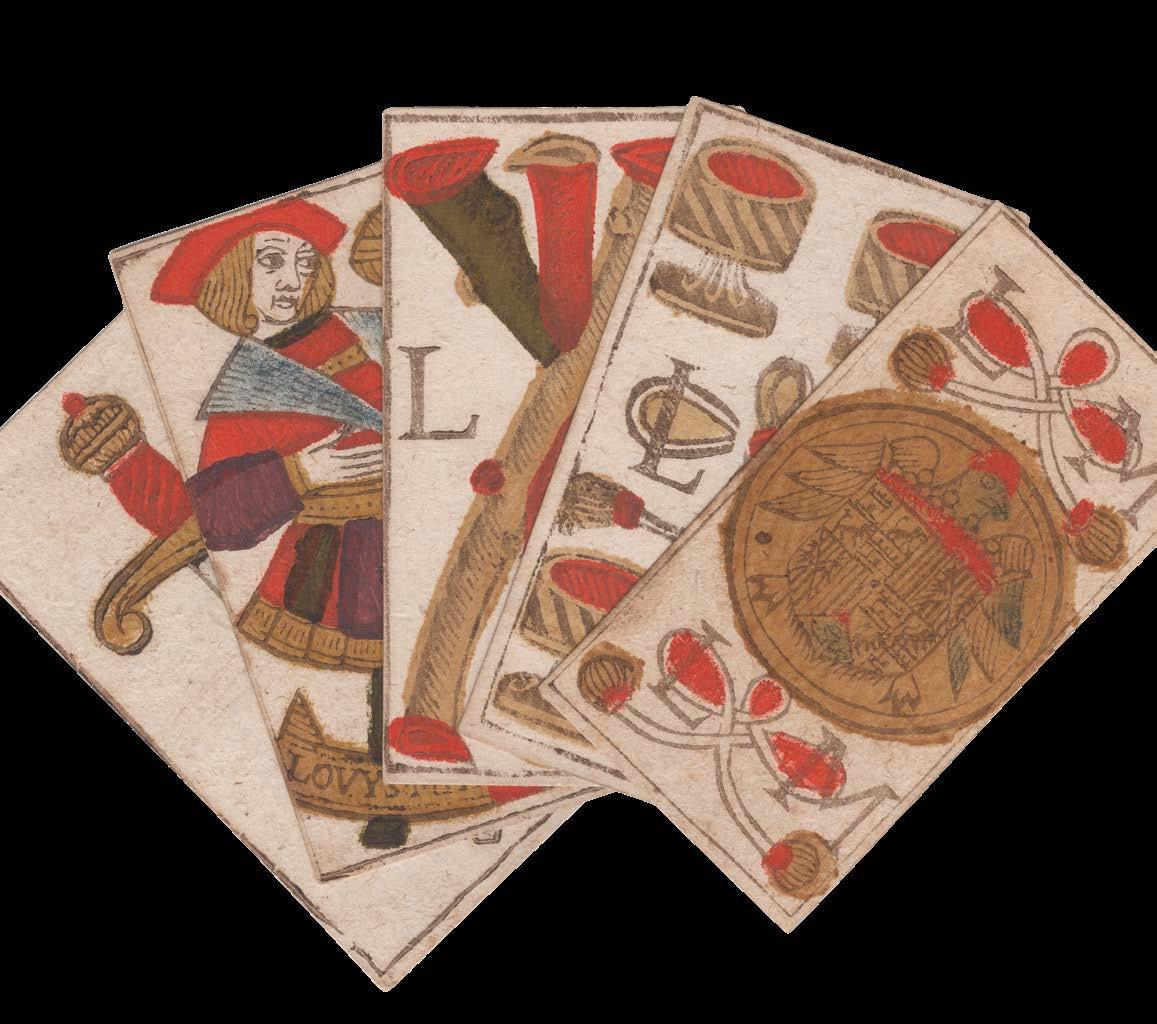
Daniel Crouch Rare Books Ltd 4 Bury Street, St James’s London SW1Y 6AB
+44 (0)20 7042 0240 info@crouchrarebooks.com crouchrarebooks.com
Daniel Crouch Rare Books New York LLC
PO Box 329 Larchmont NY 10538-2945, USA
+1 (212) 602 1779
info@crouchrarebooks.com crouchrarebooks.com

ISBN 978-1-7384410-3-7
Catalogue edited by Daniel Crouch, Iona Fielding, Kate Hunter, Ellida Minelli, Mia Rocquemore and Nick Trimming Design by Ivone Chao Photography by Louie Fasciolo and Marco Maschiao Cover:
item
Terms and conditions: The condition of all books has been described. Each item may be assumed to be in good condition, unless otherwise stated. Dimensions are given height by width. All prices are net and do not include postage and packing. Invoices will be rendered in £ sterling. The title of goods does not pass to the purchaser until the invoice is paid in full. Printed by Park Communications on FSC® certified paper. Park is an EMAS certified company and its Environmental Management System is certified to ISO14001. 100% of the inks used are vegetable oil based, 95% of press chemicals are recycled for further use and, on average 99% of any waste associated with this production will be recycled. This document is printed on Galerie Matt made of material from wellmanaged, FSC®-certified forests and other controlled sources. The pulp used in this product is bleached without the use of chlorine (ECF).
1
Every Hand’s a Winner
MILLIEU, Louys
[Toulouse/Girona pattern playing cards].
The Toulouse-Girona pattern
The Maker
The name “Louys Millieu” appears on the Knave of each suit, and the “LM” monogram on several of the pip cards. This cardmaker remained unknown for a long time until 2016, when his name was found in the City Registers of Lyons, in which he was listed as a cardmaker active in the city between 1630 and 1650.
The Cards
Taking the Spanish suits of Clubs, Coins, Cups and Swords, this deck has three court cards in each suit - rey (king), caballo (knight) and sota (knave) - and pip cards Ace to Nine, the value of each represented by the number of suitmarks shown. The court cards are drawn in the ToulouseGirona pattern, with the Sota cards bearing ribbons containing the maker’s name, although the Sota of Clubs here lacks one. The pattern, which may have been made for export, became obsolete by the end of the seventeenth century. The Ace of Coins here has at its centre the Spanish coat-of-arms.
Provenance
Sylvia Mann (1924-1994) one of the most influential collectors of playing cards of the twentieth century.
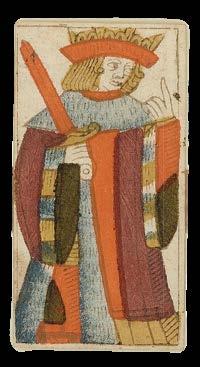

4 DANIEL CROUCH RARE BOOKS EVERY HAND’S A WINNER
Publication
Description
£85,000
[Lyons], Louis Millieu, [c1630-50].
48 woodcut playing cards with original hand-colour, pattern to versos. Dimensions 86 by 45mm (3.5 by 1.75 inches).
1


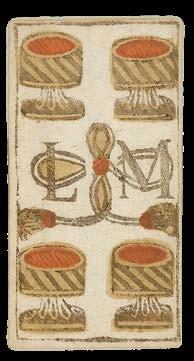
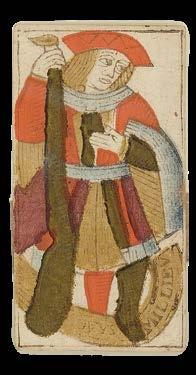

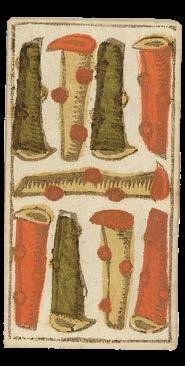
Around the world in 52 cards
[WINSTANLEY, Henry]
[Geographical Playing Cards].
Publication
[?London, 1676].
Description
49 of 52 engraved playing cards, with red tax stamp on Five of Clubs.
Dimensions
94 by 60mm (3.75 by 2.25 inches).
£20,000
The Maker
Henry Winstanley was an English painter, engineer and merchant whose Grand Tour of Europe from 1669 to 1674 inspired him to pursue the art of engraving, which he may have studied under Wenceslaus Hollar. He is, however, perhaps best known for the construction of the first lighthouse on the Eddystone Rocks near Plymouth. Unfortunately, his confidence in his construction stretched a little too far, and his boast that it would shelter him during “the greatest storm there ever was” proved false when he lost his life within it during a storm of 1703! It appears that the present deck of playing cards was the only one ever made by Winstanely.
The Cards
As well as being playable cards, with the value given in the upper corners, Winstanley’s deck also provides a huge amount of information about the geographical and ethnological understanding of the time. Each card is focused on the peoples of a certain region, including the English, Germans, Indians and Monguls, with one or two figures representing these peoples illustrated on the upper half of the card, set against their native background. The lower half contains a detailed description of the corresponding geography and ethnology in miniscule text.
On the Three of Clubs, a Chilean man and woman stand wearing little more than feathers, the woman holding a tall bow and arrows, and the man a hunting spear. In the background behind them “St Iago” is depicted as a small cluster of low buildings surrounded by forest. The description below begins: “Chili, Magellanica & Tacuman are three regions or are at provinces reaching from the 25 to the. 53 deg[ree] south lati[tude], being all the great point of the Southern America that stretches to make the famous Strait of Magellan where the two mighty seas have communication, and the only passage yet found to make the circuit of the world upon the waters. All these countries have none but Spanish Colonys but the natives are almost as much masters as they and maintains a great part governed by their chiefs, or heads of familys in Chili. The Spaniards has a Governor at St. Iago...”.
Interestingly, each of the suits is accompanied by a different motif: clubs with stars, diamonds with suns, hearts with roses, and spades with moons. It is not clear what these alternative symbols are supposed to represent. Winstanley’s cards were originally bound in a small book, and must have proved popular, as they were posthumously reissued around 1715.
6 DANIEL CROUCH RARE BOOKS EVERY HAND’S A WINNER
2
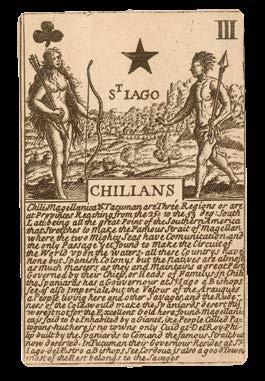


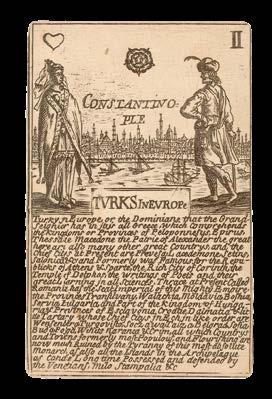


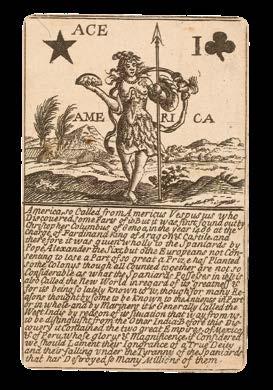
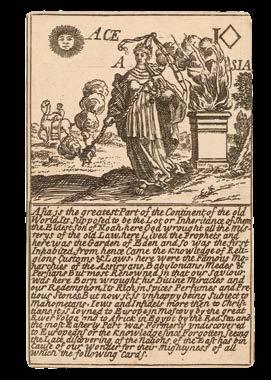

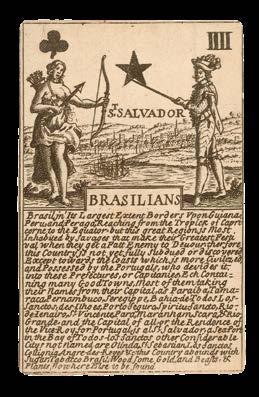

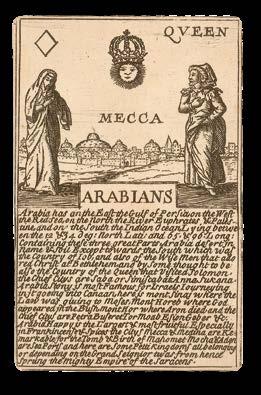
[after Francis BARLOW]
[The Popish Plot].
Publication [London, c1679].
Description
52 engraved playing cards.
Dimensions
90 by 55mm (3.5 by 2.25 inches).
References
Hulton, P.H., ‘A Volume of Drawings by Francis Barlow’, The British Museum Quarterly, 20(1), 1955.
£24,000
Playing with the Popish Plot
The Maker
Known as “the father of British sporting painting”, Francis Barlow was one of the most prolific illustrators and printmakers of the seventeenth century, as well as Britain’s first wildlife painter. Barlow was particularly well-respected for his intricate depictions of the native flora and fauna, 12 of which were published in print form in 1671, etched by legendary Czech artist Wenceslaus Hollar. Barlow is also credited as the creator of one of the earliest comic strips, ‘A True Narrative of the Horrid Hellish Popish Plot’, published in 1682, which also serves as an example of the political satire he produced in the lead up to the Glorious Revolution. It is thought that from roughly 1677 to 1679, Barlow produced a number of designs intended for decks of playing cards, concerning the so-called Rump Parliament, Aesop’s fables, and the Popish Plot, themes which he expounded upon both before and after in further works.
The Cards
The cards tell the story of the ‘Popish Plot’, with various aspects of the conspiracy hatched on the Ace of each suit, and the account continued through the pip cards to a denouement on the King. The value of each card, for anyone actually wishing to play, is given as a Roman numeral, or word in the case of the court cards, in the upper right-hand corner, with the suit mark appearing in the upper left.
Between 1678 and 1681, anti-Catholic sentiment throughout England was whipped up into a hysteria by Protestant priest, Titus Oates, and the so-called ‘Popish Plot’ that he allegedly uncovered, as shown on the King of Hearts. Oates made claims of an underground plot to assassinate Charles II, accusations which led to a ‘purge’ of Catholics in London, in which 15 men were executed. Finally, public opinion turned against Oates and he was arrested for sedition, fined, and imprisoned in late-1681. Four years later, when the Catholic James II ascended to the throne, he increased Oates’ sentence to life imprisonment, and decreed that he would be “whipped through the streets of London five days a year for the remainder of his life”.
Since the present cards do not show Oates’ fall from grace, they appear to have been produced when anti-Catholic feelings remained prominent. In fact, prints were commonly used at this time to fuel and manipulate public anxieties, and the playing cards may therefore have served as another way to promote political propaganda among the populace. Surviving advertisements for the deck show that the cards were sold in packs, or in sheets “to adorn studies and houses”, for the very affordable cost of eight old pence. Indeed, the cards proved sufficiently popular to warrant the publication of at least three editions.
10 DANIEL CROUCH RARE BOOKS EVERY HAND’S A WINNER
3
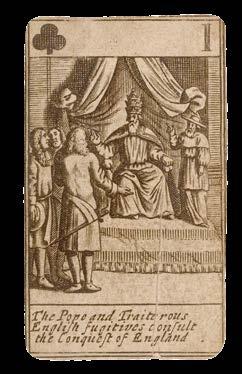

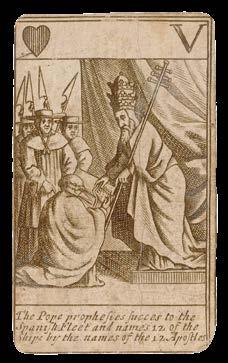
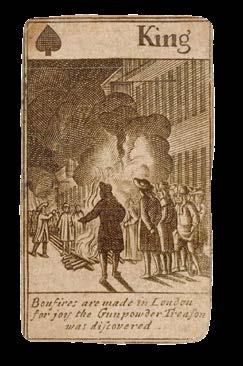
BARLOW, Francis
Knavery of the Rump.
Publication
London, R[andal] T[aylor], [1679].
Description
52 engraved playing cards, with title card.
Dimensions
90 by 54mm (3.5 by 2.25 inches).
£26,000
Play your rump card
The Maker
Known as “the father of British sporting painting”, Francis Barlow was one of the most prolific illustrators and printmakers of the seventeenth century, as well as Britain’s first wildlife painter. Barlow was particularly well-respected for his intricate depictions of the native flora and fauna, 12 of which were published in print form in 1671, etched by legendary Czech artist Wenceslaus Hollar. Barlow is also credited as the creator of one of the earliest comic strips, ‘A True Narrative of the Horrid Hellish Popish Plot’, published in 1682, which also serves as an example of the political satire he produced in the lead up to the Glorious Revolution. It is thought that from roughly 1677 to 1679, Barlow produced a number of designs intended for decks of playing cards, concerning the so-called Rump Parliament, Aesop’s fables, and the Popish Plot, themes which he expounded upon both before and after in further works.
The Cards
Following the execution of King Charles I and the purge of his supporters in 1649, the English Parliament was left with a reduced number of members, giving rise to its nickname the Rump Parliament, with rump in this case meaning a remnant or residual part. During the short-lived Commonwealth period, this Rump Parliament passed numerous acts limiting religious, legal, cultural and commercial practices in the name of “godliness”. These acts are satirised on Barlow’s cards, each of which is dedicated to a different element or scene of the Interregnum rule.
The Ten of Clubs, for example, sarcastically shows “Oliver seeking God while the K[ing] is murthered by his order”, while the Ace of Clubs questions whether the Parliamentarians had instituted “a free state or a tolleration of all sort of villany”, with officials shown raiding a house and harassing a woman on the street. In addition to more official scenes such as “the taking of the Holy League and Covenant”, Barlow’s designs also illustrate rural and everyday situations, with humble figures such as a waggoner, a weaver and a carpenter.
It is not entirely clear why cards depicting “the Rump and the dreggs of the house of Com[mons] remaining after the good members were purged out” (Ten of Hearts) were published three decades after the event. Nonetheless, Barlow’s biting satire and colourful illustrations proved perenially popular, and an example of the deck is known to have been owned by Lord Nelson. For use in play, the value of each card is given as a Roman numeral, or name in the case of the court cards, in the upper right-hand corner, with the suit symbol in the upper left.
Rare. We are unable to trace another example complete with the title card.
12 DANIEL CROUCH RARE BOOKS EVERY HAND’S A WINNER
4
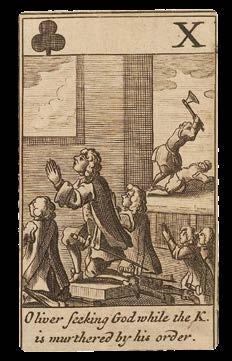
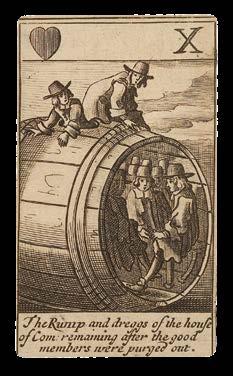
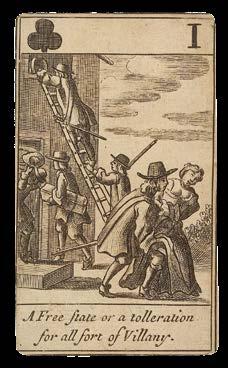

[ANONYMOUS]
[Silk and brocade playing cards].
Publication [?Germany, c1680].
Description
36 playing cards, coloured silk and brocade laid between paper.
Dimensions
93 by 65mm. (3.75 by 2.5 inches).
References
Hargrave p.108; van den Bergh pp.36-37.
£75,000
A luxury silk and brocade deck
The Maker
There is no information on the present deck of cards about its maker, but the nature of the materials used demonstrate that he or she must have been working for some extremely wealthy clients.
The Cards
The present cards are uniquely luxurious, each one being comprised of layers of coloured silk and brocade laid between two sheets of paper. The different layers of fabric give the images added depth, which reinforces the sense of meticulous craftsmanship.
It has been tentatively suggested that hearts represent France, with Louis XIV as King; spades Russia, with Peter the Great as Tsar - the jack bears the double headed-eagle of the Russian Empire; clubs, the Holy Roman Empire, with Leopold I as Emperor - he holds a shield bearing the imperial eagle; and diamonds, the Ottoman Empire with - possibly - Mehmed IV as Sultan; the jack holds a falcon: falconry was one of the most popular pastimes in the Ottoman court.
The janiform eagle, which had been a symbol of the German emperors since the fifteenth century, also suggests a German origin for these cards. Indeed, Hargrave records another deck of silk trappola cards from the seventeenth century which appear to have been made in Germany.
We are aware of one other similar complete set: in the van den Bergh Collection.
14 DANIEL CROUCH RARE BOOKS EVERY HAND’S A WINNER
5
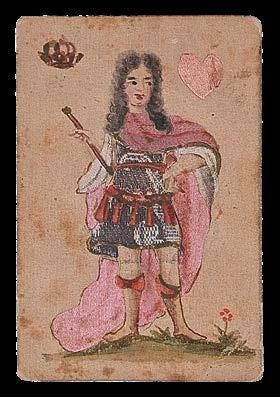
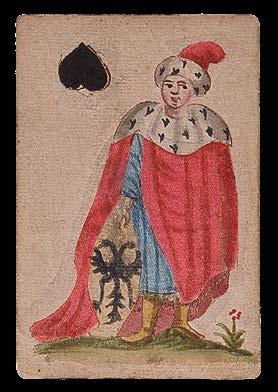
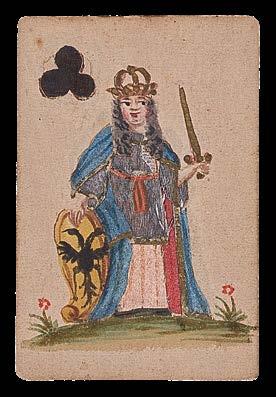


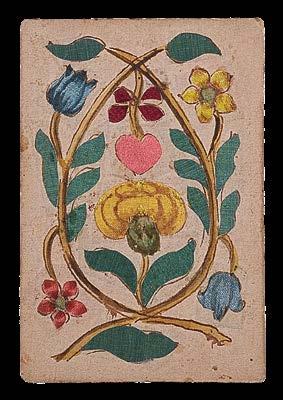

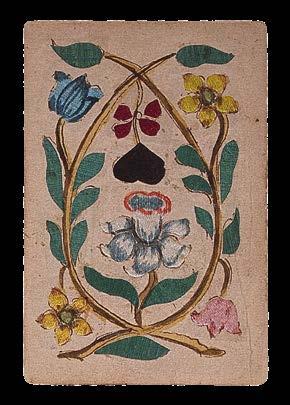
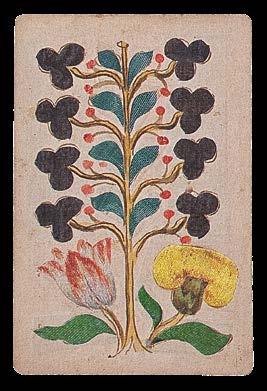
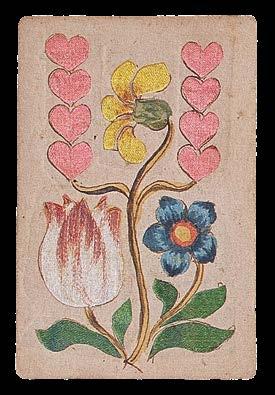
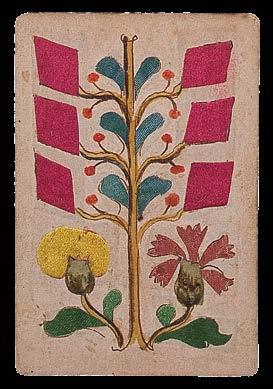
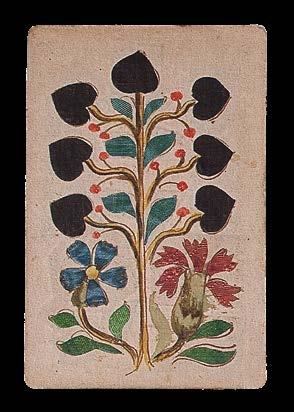
[?BARLOW, Francis]
[Reign of James II].
Publication [London, c1688].
Description
52 engraved playing cards.
Dimensions
88 by 56mm (3.5 by 2.25 inches).
£24,000
The Glorious Revolution
The Maker
Known as “the father of British sporting painting”, Francis Barlow was one of the most prolific illustrators and printmakers of the seventeenth century, as well as Britain’s first wildlife painter. Barlow was particularly well-respected for his intricate depictions of the native flora and fauna, 12 of which were published in print form in 1671, etched by legendary Czech artist Wenceslaus Hollar.
Barlow is also credited as the creator of one of the earliest comic strips, “A True Narrative of the Horrid Hellish Popish Plot”, published in 1682, which also serves as an example of the political satire he produced in the lead up to the Glorious Revolution. It is thought that from roughly 1677 to 1679, Barlow produced a number of designs intended for decks of playing cards, concerning the so-called Rump Parliament, Aesop’s fables, and the Popish Plot, themes which he expounded upon both before and after in further works.
The Cards
This deck illustrated the events that led to the Glorious Revolution of 1688, which saw the deposition of James II and the ascension of William of Orange, thenceforth William III. After only three years on the throne, James was faced with widespread opposition to his Catholic and pro-French reign; in fact, there was a call from a group of English noblemen to persuade William, his Protestant nephew (and son-in-law!) to come to England with an army. In 1688 he conceded, as shown on the Three of Diamonds: “The Prince of Orenge setts out a Fleet of 60 great ships and 500 small for ye releif of England”.
On the Six of Spades are depicted “maney of ye Nobility of England in Councell about ye Dainger of England”, while “The King leaving London about three a Clock in the Morning in his barge” appears on the Two of Hearts. James was eventually forced to flee to France, after failing to reinstitute his reign from Ireland, and he lived out the remainder of his days under the protection of King Louis XIV until his death from a stroke in 1701.
18 DANIEL CROUCH RARE BOOKS EVERY HAND’S A WINNER
6

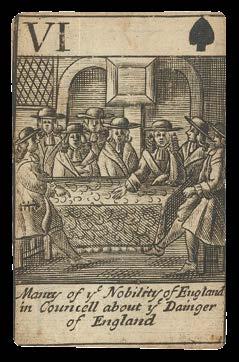
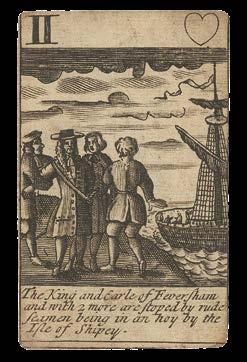
 MOXON, Joseph [and] James
MOXON, Joseph [and] James
[The Genteel House-keeper’s Pastime].
Publication [London, Joseph Moxon, 1693].
Description
18 of 52 engraved playing cards.
Dimensions
88 by 58mm (3.5 by 2.25 inches).
£14,000
Cookery Cards
The Maker
An English printer and instrument maker, Joseph Moxon’s father was also a printer, and took him as a young man to see Bibles being printed in the Low Countries. Moxon and his brother James became leading printers of mathematical and scientific texts, as well as makers of globes, instruments and, less prolifically, cards. In addition to the present deck, the Moxon brothers appear to have printed only three others: a set of geographical playing cards, a set of astronomical ones, and a set themed around the principles of geometry and mechanics, all published in the 1690s.
The Cards
These curious and extremely rare cards were originally advertised by the Moxon brothers as “The Genteel House-keeper’s Pastime: Or, the mode of carving at the Table, represented in a pack of playing cards. Set forth by several of the best masters in the faculty of carving, and published for publick use”. The 52-card deck, of which the present example contains 18 cards, was accompanied by a 46-page booklet that expounded upon the art of cutting and carving all range of meats and fish, “so as (according to its size) it may decently appear at the table to the last: when as the disorderly mangling a joynt or dish of good meat, is not onely an unthrifty wasting of it, but sometimes the cause of loathing, to a curious Observer, or a weak stomack”.
The cards themselves are each illustrated with an example of suitable gastronomic presentation, organised under four themes. The spades show all manner of pies, the hearts present butcher’s diagrams for large cuts of meat such as calf and “pigg”, the diamonds poultry, and the clubs fish. The illustrations are labelled with a short title. The suit mark appears in the upper right-hand corner of each card, with the value of the pip cards written as a Roman numeral on the upper left, and the court cards with a jack, queen or king illustrated in the upper centre.
20 DANIEL CROUCH RARE BOOKS EVERY HAND’S A WINNER
7


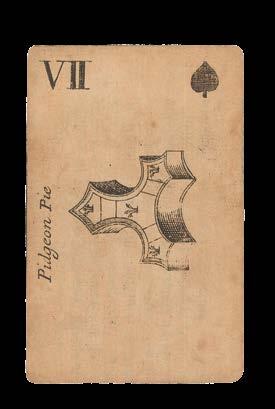

Cartes antérieures a 1710.
Publication [?Germany, c1710].
Description
36 engraved playing cards with fine original hand-colour, with one blank card with manuscript note in black ink, housed in marbled paper-covered slipcase, with pasted label.
Dimensions
96 by 54mm (3.75 by 2.25 inches).
£15,000
The Maker
There is no imprint on the cards or slipcase to identify the maker of this deck. The manuscript note on the additional blank card, however, reads ‘Alle 36 Stück gekauft um F.II. 2 a. den 3ten März 1804’, providing an indication of when the cards were sold. This is at odds with the label on the slipcase, which suggests its contents are “cards earlier than 1710”; the garments worn by the figures on the cards certainly correspond to seventeenth century German dress.
The Cards
The cards in this interesting deck are divided equally between the standard French suits, but rather than the cards in each suit being labelled one to nine, as normal for a 36-card deck, they are consecutively numbered one to 36. While it would in theory be possible to play a game with such cards, with a higher number beating a lower one, there does not appear to be any widely-played game whose format corresponds to that of this deck. In fact, it is possible that they were ceremonial cards.
Each card shows a full length figure in a variety of garments, from the elaborate outfits of the nobility to the peasant’s garb. Women outnumber men, and many are shown with ornate hats and head-dresses, or holding various objects including vases, flowers and, in two cases, children. The figures are captioned beneath the image in both German and French.
22 DANIEL CROUCH RARE BOOKS EVERY HAND’S A WINNER
[ANONYMOUS]
8
Franco-German fashion cards

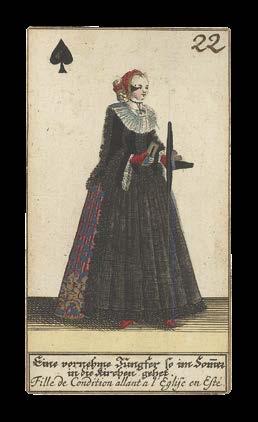


SPOFFORTH, R[obert]
[Royal Cards - Reign of Queen Anne].
Publication
[London, Robert Spofforth, 1705].
Description
47 of 52 engraved playing cards, with red tax stamp on Ace of Spades.
Dimensions
88 by 60mm (3.5 by 2.25 inches).
£7,500
Queen of Hearts
The Maker
The Ten of Diamonds and Four of Clubs bear the imprint of English engraver and printseller Robert Spofforth. Active in London during the first decade of the eighteenth century, Spofforth produced a variety of work including frontispieces, portraits, miniatures, commemorative prints, heraldry and one deck of playing cards.
An advert published on New Year’s Day of 1705 announced that “this day is published a new invented Pack of Cards, in which are described in Pictures done from copper plates, finely engraved the various transactions of Her majesty’s most glorious reign to the present, historically dispos’d according to the order of time in which they happened. Price 1s 6d a Pack”.
The Cards
Queen Anne reigned from 1702 to 1714, with the Acts of Union, which saw England, Scotland and Ireland united as Great Britain, passed in the middle of this period. Heavily involved in both politics and culture, she proved to be a popular monarch, especially in comparison to her predecessor, the largely disliked William III. The present deck of cards, however, was first published two years before this historic change, and therefore the scenes displayed, such as the Siege of Bon (Five of Clubs), Her Majesty’s visit to Bath (Six of Hearts) and the start of the War of the Spanish Succession (King of Diamonds), all took place in the early years of her rule.
The value of each card is represented in the upper right-hand corner with the Arabic numeral, or name in the case of the Jack, Queen and King cards, and the suit mark is given on the opposite side. The court cards seem to have been reserved for some of the most significant moments of Queen Anne’s reign thus far. The Queen of Hearts, for instance, shows “Queen Anne crown’d Apr. 23. 1702”, while the King of Heats depicts the moment of “Her M[ajes]tys first appear[an]ce in Parliam[en]t March II 1702”.
24 DANIEL CROUCH RARE BOOKS EVERY HAND’S A WINNER
9
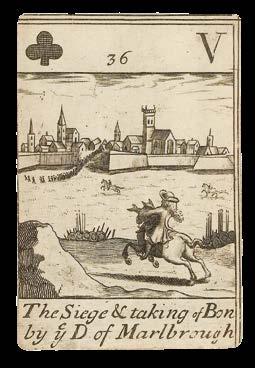


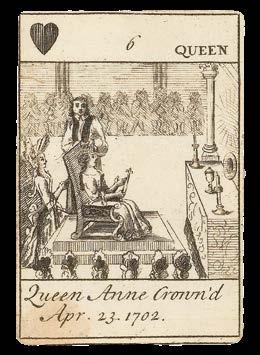
SPOFFORTH, R[obert]
[Royal Cards - Reign of Queen Anne].
Publication
[London, Robert Spofforth, 1705].
Description
49 of 52 engraved playing cards, damage to Four of Clubs.
Dimensions
88 by 60mm (3.5 by 2.25 inches).
£10,000
Queen of Hearts
The Maker
The Ten of Diamonds and Four of Clubs bear the imprint of English engraver and printseller Robert Spofforth. Active in London during the first decade of the eighteenth century, Spofforth produced a variety of work including frontispieces, portraits, miniatures, commemorative prints, heraldry and one deck of playing cards.
An advert published on New Year’s Day of 1705 announced that “this day is published a new invented Pack of Cards, in which are described in Pictures done from copper plates, finely engraved the various transactions of Her majesty’s most glorious reign to the present, historically dispos’d according to the order of time in which they happened. Price 1s 6d a Pack”.
The Cards
Anne reigned from 1702 to 1714, with the Acts of Union, which saw England, Scotland and Ireland united as Great Britain, passed in the middle of this period. Heavily involved in both politics and culture, she proved to be a popular monarch, especially in comparison to her predecessor, the largely disliked William III. The present deck of cards, however, was first published two years before this historic change, and therefore the scenes displayed, such as the Siege of Bon (Five of Clubs), Her Majesty’s visit to Bath (Six of Hearts) and the start of the War of the Spanish Succession (King of Diamonds), all took place in the early years of her rule.
The value of each card is represented in the upper right-hand corner with the Arabic number, or name in the case of the Jack, Queen and King cards, and the suit mark is given on the opposite side. The court cards seem to have been reserved for some of the most significant moments of Queen Anne’s reign thus far. The Queen of Hearts, for instance, shows “Queen Anne crown’d Apr. 23. 1702”, while the King of Heats depicts the moment of “Her M[ajes]tys first appear[an]ce in Parliam[en]t March II 1702”.
The present deck has the illustration of Queen Anne’s coronation reversed, so that the monarch now faces the left.
26 DANIEL CROUCH RARE BOOKS EVERY HAND’S A WINNER
10
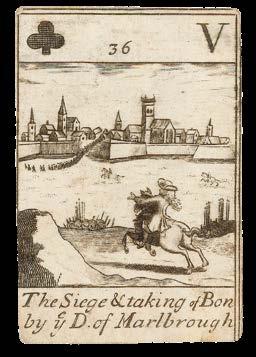



?[LENTHALL, John]
Marlborough’s Victories.
Publication
[London, ?John Lenthall, 1707].
Description
52 engraved playing cards.
Dimensions
91 by 62mm (3.5 by 2.5 inches).
£20,000
A pack of Marlboroughs
The Maker
Although the maker of the cards cannot be identified with certainty, they bear similarities to the work of John Lenthall, a Fleet Street stationer who sold at least 40 different sets of cards during the first quarter of the eighteenth century.
The Cards
With a career that spanned the reigns of five monarchs, John Churchill, First Duke of Marlborough experienced frequent waxings and wanings of his popularity and power during the late-seventeenth and early-eighteenth centuries. Having played a part in both the ascension and deposition of James II, been both rewarded and punished by William III, and having switched his allegiances from Protestantism to Catholicism and back again, Churchill finally seemed to find a stable position of influence during the reign of Queen Anne, with whom his wife was, at that time, close friends.
Throughout the Queen’s reign, the Duke of Marlborough distinguished himself in many military conflicts while fighting as the de facto leader of the Allied forces. His victories at Blenheim in 1704, Ramilies in 1706, Oudenarde in 1708 and Malplaquet in 1709 won him a reputation throughout Europe, one that is celebrated on the present deck of cards.
Elaborately illustrated with detailed representations of his triumphs, the cards convey the contemporary beatification of Marlborough by the British public. The Ace of Diamonds shows Victory flying over London, thanks of course to the efforts of Marlborough: “Happy is ye city, Victorious made Like to Augusta both for wealth and trade, The Thames shall glide to France & bring to thee As Marlbro’ does ye fruits of Victory”. The Six of Clubs shows “The medal struck at Utrecht upon ye Victorie obtain’d at Ramelies”: an allegory of Queen Anne (“Anna Major”) styled as the goddess Minerva standing victorious over Louis XIV (“Ludovicus Magnus”). In fact, the spade suit consists almost entirely of a series of biting attacks on Louis XIV: he is represented on the Ace as a “fat cat”, while the Four suggests that he drinks blood, “the best cordial”!
The value of the cards is denoted by a suit symbol in the upper right-hand corner, and a Roman numeral, or name in the case of the court cards, in the upper left. Some of the court cards are represented by busts of the European monarchs and leaders involved in or related to Marlborough’s battles:
Clubs: Charles III of Spain, Queen Anne
Diamonds: Victor Amadeus of Savoy, Princess Royal of Prussia
Hearts: George of Denmark, Anna Sophia of Hanover
Rather inconsistently, Prince Eugene of Savoy appears on the Ten of Clubs, while the King and Queen of Spades, as well as the various Jacks, simply show more scenes of battle or its aftermath.
28 DANIEL CROUCH RARE BOOKS EVERY HAND’S A WINNER
11
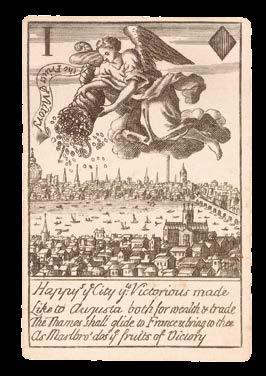

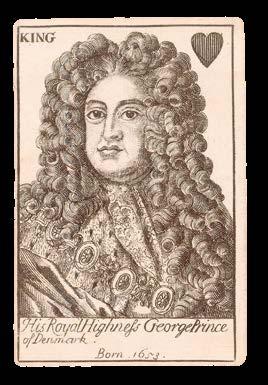
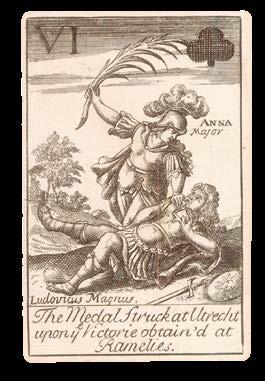
[?LENTHALL, John]
[Monmouth’s Rebellion] [and]
[Newspaper Advertisement for Monmouth’s Rebellion].
Publication
[London, ?John Lenthall, c1710-1730].
Description
52 engraved playing cards, with circular, dampstain to Ace of Spades [and] newspaper leaf.
Dimensions
87 by 55mm (3.5 by 2.25 inches).
£9,500
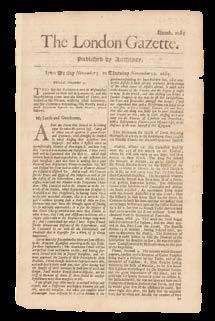
Monmouth’s Rebellion
The Maker
The cards were probably issued originally as Whig propaganda in 1685 after the failed rebellion. Given their style, particularly how the value and suit of each card is given above the illustrated scene and caption, the present deck may have been reissued in the early eighteenth century by John Lenthall, the London card maker and stationer who reissued at least 40 decks of cards from earlier or foreign makers.
The Cards
The events and key figures of the Monmouth Rebellion are depicted on this deck of playing cards, each scene with a short caption beneath. The shortlived Monmouth Rebellion began just three months after the ascension of James II in February 1685. Leading the rebellion was James Scott, First Duke of Monmouth and illegitimate son of the previous King Charles II, who opposed the new Catholic rule.
Although in exile during the first month of the rebellion, the Duke landed at Lyme Regis on June 11 (Ace of Clubs: “The late D. of M & other Rebells taking shipping for England”) and took control of the disparate group of rebels. His efforts ultimately failed, however, since his forces were unable to stand up to the might of the king’s army. The rebellion ended with Monmouth’s defeat at the Battle of Sedgemoor and his execution by decapitation less than two weeks later (Seven of Spades: “The late D of M beheaded on Tower Hill 15 July 1685”).
The value of each card is given at the top, with the suit mark on the right and either a Roman numeral or the name of the court card on the left.
The accompanying clipping from a newspaper printed in 1685 advertises “A New Pack of Cards, Representing (in curious lively Figures, the two late Rebellions throughout the whole course thereof in both Kingdoms, Price one Shilling. Sold by D. Brown at the Black-Swan and Bible without Temple-Bar, and A. Jones, at the Flying-horse in FleetStreet near St. Dunstans Church”.
30 DANIEL CROUCH RARE BOOKS EVERY HAND’S A WINNER
12
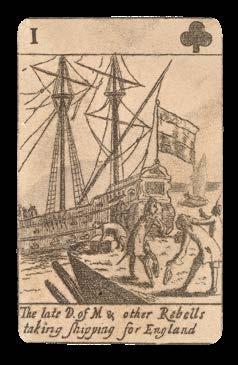
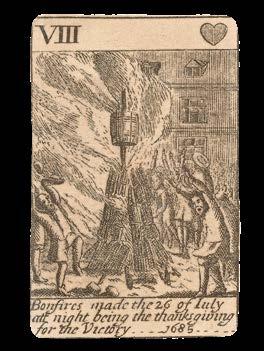

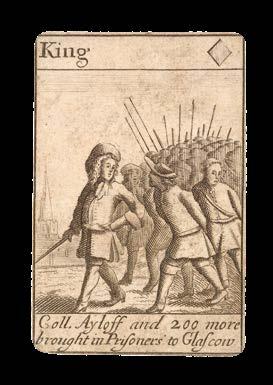
[ANONYMOUS]
[Delightful Cards].
Publication [London, c1723].
Description
50 of 52 engraved playing cards with original hand-colour.
Dimensions
92 by 60mm (3.5 by 2.25 inches).
£8,000
Delightful Cards
The Maker
These cards were first advertised in December 1723 as “Delightful Cards, containing variety of entertainment for young Ladies and Gentlemen who will be agreeably diverted price two shillings a pack.” While in style the etchings have been compared to the work of Hogarth, who was beginning to rise to prominence at this time, the maker cannot be identified with any certainty.
The Cards
On each of the cards is depicted a detailed scene with two lines of rhyming verse beneath serving as a caption. The subjects vary from allegorical to military, but all are characterised by humour. On the Seven of Diamonds a woman is shown fishing on the banks of the river; the text below reads “The fish with admiration round her wait / and Gladly swallow the deceitful bait”. It is not clear whether the “fish” is referring to the creatures in the water of the young man watching her from the opposite bank!
The court cards are not clearly distinguished from the pip cards by subject. The King of Clubs shows a performer, captioned “Spectators round about doe crow’d / He has got their money which makes his very proud”. The Queen cards, however, do seem to display feminine subjects and figures. Depicted on the Queen of Diamonds is a woman lounging on a couch and looking into a large mirror, with the text below reading “Beauty like lightning does our eyes invade / They that presume to gaze are victims made”. On the Queen of Spades is an allegorical woman surrounded by nature, captioned “Peace and Plenty are great joys of life / That man is happy who has a good wife”.
The value and suit of each card is indicated by a miniature representation of the full card in the upper left-hand corner, the court cards with a three-quarter length figure of the jack, queen or king.
32 DANIEL CROUCH RARE BOOKS EVERY HAND’S A WINNER
13
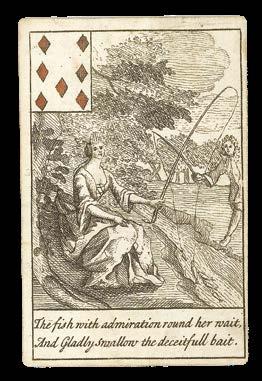


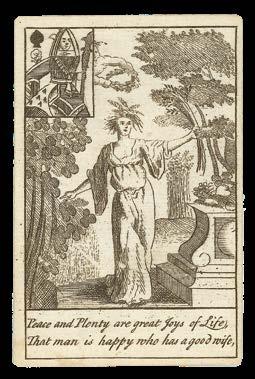
[BERMAN, Jeremias]
Les Cartes Musiciennes.
Publication
[Vienna, Edersche Kunsthandlung, c1730].
Description
32 engraved playing cards with fine original hand-colour.
Dimensions
87 by 57mm (3.5 by 2.25 inches).
£1,200
A musical arrangement
The Maker
In 1811 Viennese cardmaker Jeremias Berman entered the business of his father-in-law, who published music, prints and greeting cards. In 1815, Berman became the sole owner of the business, which then employed several hundred staff, and under his leadership it expanded its output to include a wider range of prints and maps, as well as greeting cards that were mechanically moved by turning, pulling or folding pieces of paper. Although he published a New Year’s greetings card featuring a character holding playing cards, there are no records of Berman producing any other decks during his career.
The Cards
Suitable for a firm with a history of publishing music, including Beethoven’s Piano Sonata No.10, Berman’s cards each feature two short lines of musical score. It appears that when joined in a certain order, the bars are joined in such a way as to show a complete musical score. Above the notes on each card is a miniature representation of its value in typical form: the pip cards with their value represented by the number of clubs, diamonds, hearts or spades; the court cards with a single full-length figure coloured in yellow, blue, red and black.

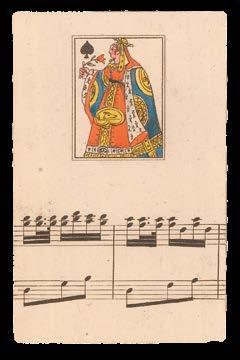
34 DANIEL CROUCH RARE BOOKS EVERY HAND’S A WINNER
14

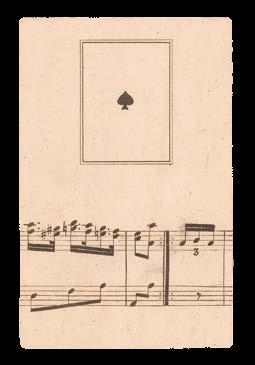

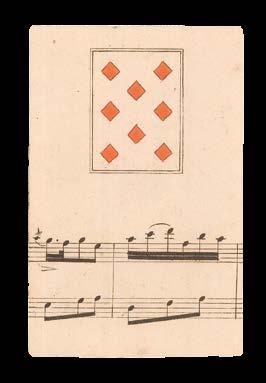
LENTHALL, John
[Proverb Playing Cards].
Publication
[London, John Lenthall, c1730].
Description
52 engraved playing cards with original hand-colour, with red tax stamp to Ace of Spades.
Dimensions
92 by 64mm (3.5 by 2.5 inches).
£9,500
Lenthall’s proverbs
The Maker
First issued in 1698 by London stationer William Warter, the present deck was soon withdrawn due to the questionable propriety of the scenes shown. Warter’s apprentice, John Lenthall, took over the business around 1708/9 and began to re-issue a large number of playing cards from the recent decades, including this deck. In fact, in the first half of the eighteenth century, Lenthall was responsible for the production of at least 40 sets of playing cards, which were generally imported, re-engraved or re-issued editions of earlier decks.
The Cards
While being perfectly functional playing cards, with the suit mark engraved in the upper right-hand corner and the value on the left, Lenthall’s ‘proverb’ cards were clearly designed to entertain and amuse. Each card depicts a different scene with a short caption below giving a maxim related to the image shown. Some are perfectly predictable: the Two of Diamonds shows a large sail ship tossed in the waves with the caption “The more Danger the more honour”.
Others, however, are less discreet: on the Ace of Spades a man is shown defecating in front of a drift of pigs, with the text reading “A T- d’s as good for a Sour as a Pancake”; likewise the Two of Spades, which is labelled “out of sight out of mind”, shows a man appearing to cheat on his wife just the other side of a door. The court cards do not seem to be distinguished in any clear way from the pip cards, although the Queens do appear to have women and women’s work as the topics of their scenes.
36 DANIEL CROUCH RARE BOOKS EVERY HAND’S A WINNER
15
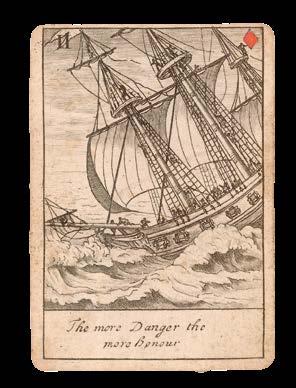

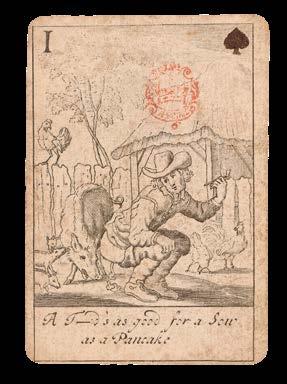

GAZÁN, Francisco
Juego de Armerías.
Publication
[Madrid, Antonio Marín, 1748].
Description
52 engraved playing cards with fine original hand-colour.
Dimensions
90 by 59mm (3.5 by 2.25 inches).
£8,000
The reign in Spain
The Maker
Spanish engraver Francisco Gazán was active in Barcelona from 1684 to 1704, and then in Madrid from 1710 to 1732. The majority of Gazán’s output consisted of devotion and heraldic prints, although during the War of Spanish Succession he also produced a number of city plans showing military skirmishes. Although some have imputed his move to Madrid as the result of his involvement in a murder, there is in reality almost no reliable information to be found about Gazán’s life outside of his career.
The Cards
In 1748, Gazán published his ‘Libro y Baraja nuevos e inseparables para aprender el blasón’, an educational book on his beloved subject of heraldry. Within the first volume was included the present deck of cards, intended as a game to reinforce the lessons of the text. The 52 cards in the deck are divided into the traditional Spanish suits of Clubs, Coins, Cups and Swords, and each card depicts a different armorial coat-of-arms from a European monarchy or leading power. The value of the card is shown, in some places rather indistinctly, in the upper right-hand corner, while the majority of the card is taken up with the detailed crest, followed by several lines of explanation in Spanish beneath.
The court cards, naturally, are reserved for the most powerful figures and families in Europe at the time:
Clubs: the King of France; Prince of the Blood; the houses of Anjou and Orleans
Coins: the Papacy; the house of Saboya; the royal house of Naples
Cups: the Spanish Emperor; the King of England; the King of Hungary and Bohemia
Swords: the King of Portugal; the King of Spain; the Spanish infantes
38 DANIEL CROUCH RARE BOOKS EVERY HAND’S A WINNER
16
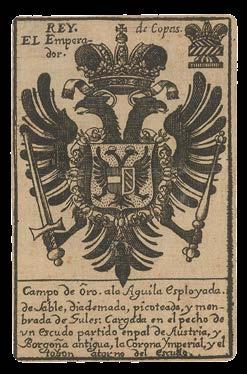
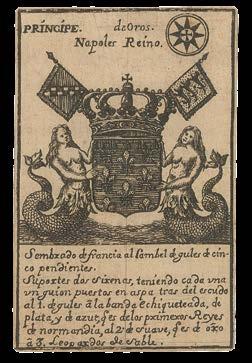


SCHENK,
Joh[an]n Heinr[ich]
[Hexenspiel cards].
Hexenspiel cards
The Maker
Description
Dimensions
£5,500
In the latter half of the eighteenth century, there were three cardmakers active in Nuremberg on whose cards the imprint “I. Schenck” is found: a father and his two sons. The present deck was made by the former, Johann Heinrich, who initially worked as a journeyman in the city from 1742 to 1751, before becoming a master and continuing his career as an independent man. He published a number of decks of playing cards using a range of suit systems and designed for several different games.
The Cards
The game of Hexenspiel, or Vogelspiel, appeared in Germany and Austria in the seventeenth century, descended from the Italian game of Cuccu and thus belonging to a family of games including the Swedish Kille and Danish Gnav. Gameplay involved a round of bidding before players attempt to capture certain cards from their opponents. Suits are not relevant in Hexenspiel, and do not even appear on specialised decks, as here, and instead it is through the rank or value of the card that players either win or lose. In the present deck there are two copies of each card, which fall into three groups: number cards from one to 12, marked with roman numerals; five trumps outranking these; four low cards below zero and a “Joker”. The top trump is the Bird which gives the name Vogelspiel to the game, followed by the Sentinel, the Horse, the Cat, and the Tavern, while the Witch, from which the title Hexenspiel comes, is a kind of magic card and defeats all others. Apart from the number cards, each one has a drawing illustrating the creature or object it represents, captioned in a banner above. To show the correct orientation of the numerals on the number cards, a colon is printed after the numeral.

40 DANIEL CROUCH RARE BOOKS EVERY HAND’S A WINNER
Publication [Nuremberg], Joh[an]n Heinr[ich] Schenck, [1760-1770].
32 woodblock printed cards with original hand-colour.
86 by 58mm (3.5 by 2.25 inches).
17
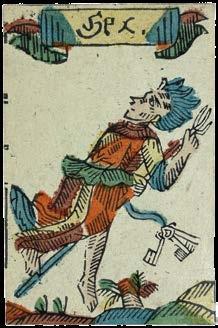
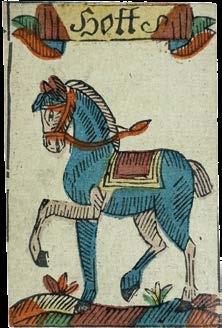
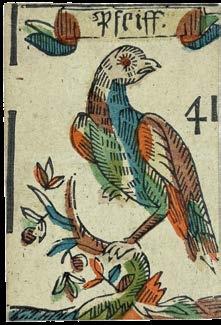
 GÖBL, Andreas Benedict Baierische Hochzeit
GÖBL, Andreas Benedict Baierische Hochzeit
[Bavarian Wedding].
Publication
[Munich], Andreas Benedict Göbl, [c1765].
Description
78 woodcut cards in original dark brown leather case.
Dimensions
110 by 59mm (4.25 by 2.25 inches).
£20,000
A royal wedding
The Maker
Little is known about Andreas Benedict Göbl, apart from that he produced playing cards in Munich during the eighteenth century. Using the French, Spanish and German suit systems, his cards spanned a range of themes, designs and patterns, from animals to nuptuals, as here.
The Cards
Using the French suits of Clubs, Diamonds, Hearts and Spades, this is a tarock deck consisting of 22 trump cards (I to XXI and a Fool, known as the Excuse in French and the Skiz in German), four court cards (King, Queen, Cavalier and Jack) and finally the Ace of each suit. The court cards show the full-length royal characters, Cavaliers mounted on horses and Queens holding flowers, while on the numbered trump cards a procession scene is shown.
It represents the ill-fated wedding day of Emperor Joseph II and Maria Josefa of Bavaria, forced by Empress Maria Theresa in 1765. Herself a grandaughter of Emperor Joseph I, Maria Josefa was described by contemporary sources as warm and good-natured but sadly unattractive and lacking in wits. She thus failed to gain her husband’s affections, and it is believed that the marriage was probably never consummated. Worse yet, Maria Josefa died only two years later when a smallpox epidemic afflicted the Viennese court to which she had been sent. The unhappy couple are shown riding - and simultaneously feasting! - in a horse-drawn carriage, followed by a number of officials, noblemen, and finally commoners. German inscriptions beneath each illustration describe the people and scenes shown.
42 DANIEL CROUCH RARE BOOKS EVERY HAND’S A WINNER
18
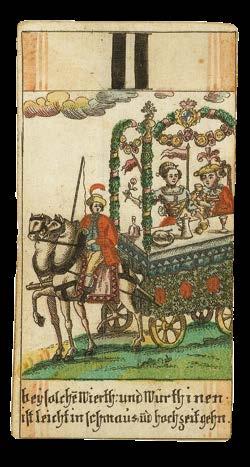
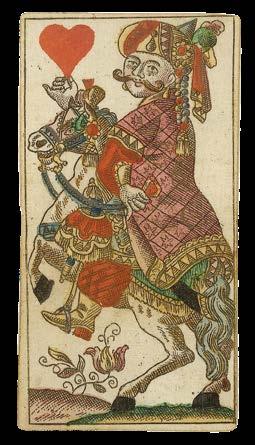
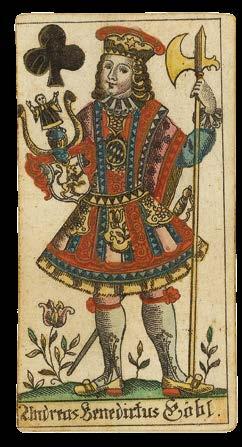
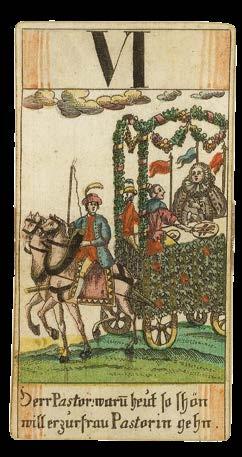
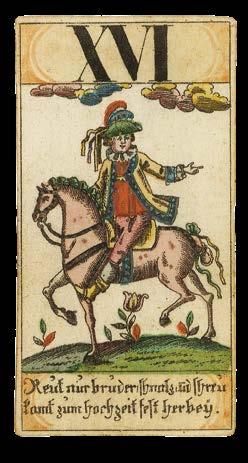

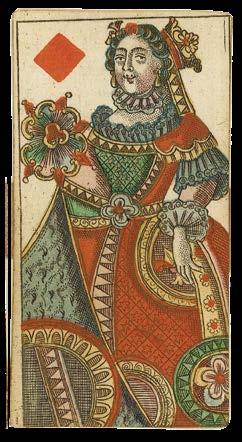
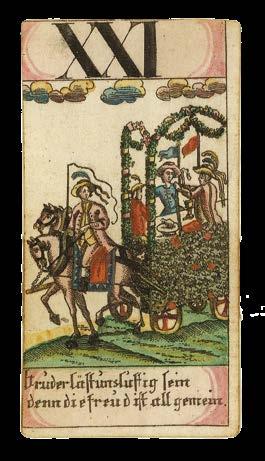

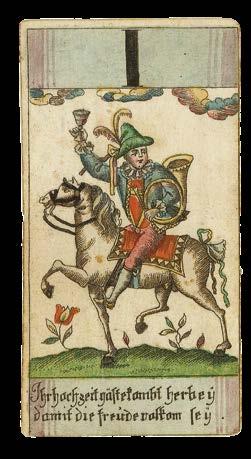
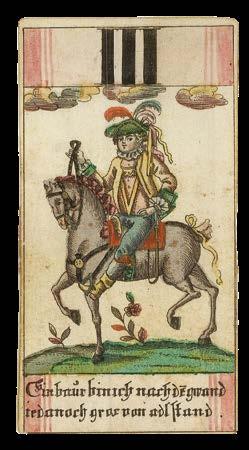

ROWLEY AND CO.
[Rowley’s new deck].
Publication
[London, Rowley & Co, c1775].
Description
52 engraved playing cards with original hand-colour, housed in slipcase with printed design to both sides, upper half lacking.
Dimensions
92 by 64mm (3.5 by 2.5 inches).
£3,000
Monarchs of Europe
The Maker
The accompanying advertisement lists the present decks as “sold at the Patentee’s Card-Manufactory, No. 6, in the Old Bailey: at the London Coffee-House, Ludgate-Hill; by M. Darly, Engraver and Printfeller, in the Strand: and by all Stationers and Country Shop-keepers - Price 2s. 6d. per Pack, or One Pound Seven Shillings per Dozen, for Ready Money only”.
Despite claiming to be a “card manufactory”, there is no evidence of any other deck of cards produced by Rowley & Co. In fact, there is no evidence of Rowley operating from No 6, Old Bailey until 1773, and by 1783, the premises were being operated by a printer named Daniel Constable, and ten years later by another named John Barker. This suggests that the firm’s output may have been limited to this one deck of cards.
From 1765, the Ace of Spades was required by the Stamp Office to carry treasury duty and die number. While earlier examples of this deck, which are otherwise identical, do not bear these marks, it appears that Rowley & Co. published the playing cards from 1773, and that the present example was made after the introduction of the requirement.
The Cards
Rowley & Co., of No. 6, Old Bailey, London, published a deck of playing cards that intended to reform the traditional English deck but which sadly never caught on. The court cards display portraits of the monarchs of England, France, Spain and Russia with their attendant Knaves, all in oval frames. It is the pip cards, however, that show the greatest departure from English tradition, with the customary suit symbols changed to Pikes, Chalices, Trefoils and Topaz, coloured respectively in black, red, green and yellow. In a three-page accompanying notice published alongside the cards, Rowley offered some explanation for his design choices:
“By the four suits, we are to understand the four classes of men into which every kingdom is divided: the Nobles, the Clergy, the Citizens and the Peasantry... The four suits have undergone but little more alteration than seemed necessary to point out their original meaning... For the Spade, is given the espontoon of our first regiment of guards. The clerical order is represented by the chalice, or sacramental cup. The Diamond is engraved to resemble the modern improved out of previous stone: which, being printed in yellow, may remind us of the Topaz: And, for our Club, the trefoil, or clover-grass, is restored both in form and in colour. We have. therefore four colours: which novelty may not be unpleasing: and it is possible that, in a. short tiem, the names of Pike, Chalice, Topaz, Clover, will be as familiar in the mouths of English card-players, as Spade, Heart, Diamond, Club.”
46 DANIEL CROUCH RARE BOOKS EVERY HAND’S A WINNER
19

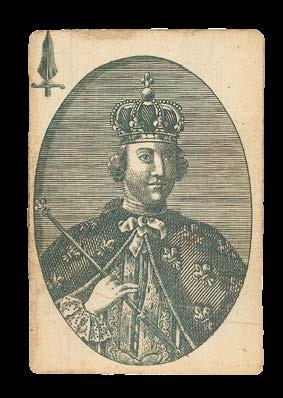

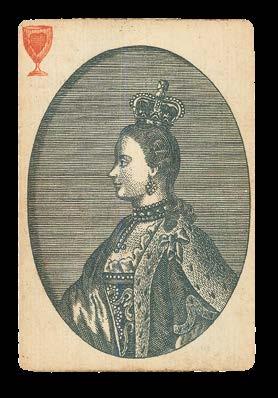
MARC, P[ierre]
French Deck “Au portrait de Paris”.
Publication
Paris, P[ierre] Marc, [c1775].
Description
52 woodblock print playing cards with original hand-colour, with stencilled colour inscription to versos.
Dimensions
83 by 55mm (3.25 by 2.25 inches).
£3,200
The Paris playing cards, with grammatical game
The Maker
The Jack of Clubs bears the imprint of the manufactuer “P. Marc” along with “G.D. Paris”, while the rest of the court cards have only “Marc” at the foot of the full-length illustration. The Jack of Clubs also shows his printing device, suitably the ‘Marc d’Or’, which was registered in the 1770s.
The Cards
This rare deck of pre-Revolution French playing cards follows the standard design conceived in Paris during the seventeenth century, with plain pip cards whose value is represented by the number of suit symbols, and court cards representing figures from history, legend and scripture:
Clubs - Alexander, Argine, Marc
Diamonds - Caesar, Rachel, Hector
Hearts - Charlemagne, Judith, La Hire
Spades - David, Pallas, Hogier
Appropriately, the Marc found on the Jack of Clubs in the original Paris design here doubles as a reference to the card-maker. ‘Argine’ on the Queen of Clubs is simply an anagram of the Latin word ‘regina’, meaning ‘queen’. Hogier on the Jack of Spades is a reference to Holger the Dane, first mentioned in the ‘Chanson de Roland’ as a Danist antagonist of Charlemagne, while La Hire on the Jack of Hearts is the nickname of the French military commander, Étienne de Vignolles, Sieur de Montmorillon, Chatelain de Longueville, whose full name and title may not have fit on the card!
The Revolution was a period of fluctuation after the banning of representing royal emblems and all reminders of the monarchy. On occasion, playing cards from this era were reinvented towards educational purposes through stencilling on the versos with letters, phonemics, denotations, numbers, and punctuation marks.
The versos of these particular cards show parts of, or full, words in French and Latin that seem to have been designed to form a separate game concerning grammar and spelling. Abbreviations on some cards, such as “v[erbe] neut[re]” and “pr[onom] dém[onstratif]” indicate that the players, probably children, were required to match up the Latin vocabulary with the corresponding grammatical form.
48 DANIEL CROUCH RARE BOOKS EVERY HAND’S A WINNER
20
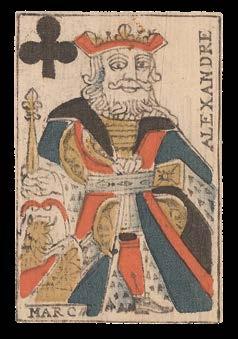
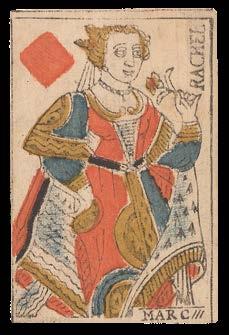

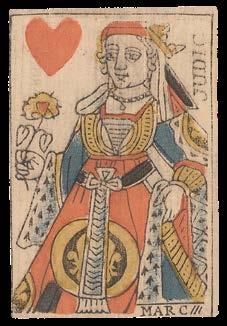
R[OXAS], C[lemente]
[Four Empires Playing Cards].
Publication
[Madrid, Clemente Roxas, c1805].
Description
46 of 48 engraved playing cards with red pattern to verso.
Dimensions
88 by 56mm. (3.5 by 2.25 inches).
£2,000
Spanish Imperial Playing Cards
The Makers
On the base of the pedestal of the King of Cups, the initials “Dn C. R.” appear, referring to Clemente Roxas, a cardmaker active in Madrid during the early nineteenth century. Roxas published decks on a variety of themes, using both the Spanish and French suit systems.
The Cards
The Spanish suits of Clubs, Coins, Cups and Swords are depicted here on the pip cards in quantities representing the value of each card. The court cards, however, show geographical distinctions, with the full-length characters of the rey, caballo and sota representing figures from various regions of the Spanish Empire as it then stood. On Clubs are represented North Africans, on Coins South American Indians, on Cups inhabitants of the Holy Roman Empire and on Swords the European colonists of America. On the Ace of Coins the arms of Castile and León are shown surmounted by crown, with a lion grasping a sword and a globe beneath it.

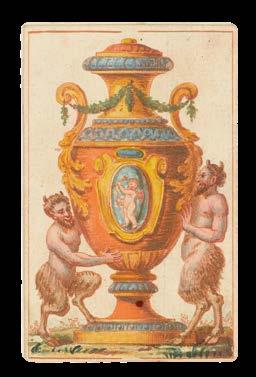
50 DANIEL CROUCH RARE BOOKS EVERY HAND’S A WINNER
21


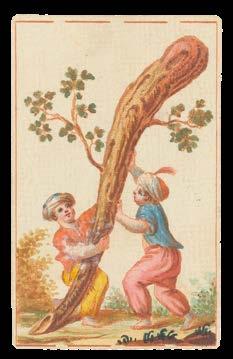
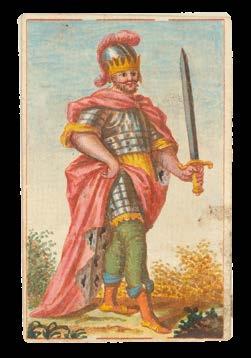
Jeu des Drapeaux.
Publication [France, c1815].
Description
32 engraved playing cards with one title card.
Dimensions
105 by 65mm (4.25 by 2.5 inches).
£5,000
Napoleon returns from exile
The Makers
This deck was made by an anonymous, but presumably French, card manufacturer around the time of Napoleon’s return from his brief exile on Elba.
The Cards
With cards Two to Six of each suit removed, the ‘Jeu des Drapeaux’ was perhaps intended for the 32-card game of belote. Published after Napoleon’s return to France from Elba in 1815, the classic French suits have each been connected to a different nation involved in the Emperor’s conflicts, with Clubs showing Russian soldiers, Diamonds the Germans, Hearts the French themselves, and the Spades depicting English, Scottish and Irish troops. The value of each card is represented by the number of soldiers shown, and there is also a miniature version of the traditional pip card which they fly as their flag.
On the court cards, each nation’s general appears as the King surrounded by aids, with Napoleon himself of course represented as the King of Hearts. Jacks are depicted as flag-bearing soldiers, while the Queens are allegorical female figures partaking in the battle. The only inscription on the cards, except the nationalities listed along the lower border, is the slogan “La Garde meurt et ne se rend pas” (’The Guard dies but does not surrender’) on the King of Hearts, the phrase cried by General Pierre Jacques Étienne Cambronne when surrender was suggested at the Battle of Waterloo.
The title card shows a French general bearing the tricolore, brandishing a sword, and standing before a pillar on which are listed the battles in which the Napoleonic troops had won victories.
52 DANIEL CROUCH RARE BOOKS EVERY HAND’S A WINNER
[ANONYMOUS]
22
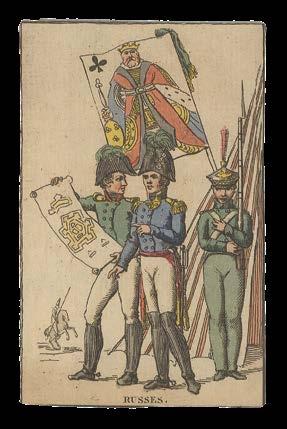

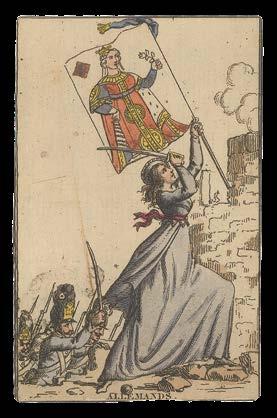
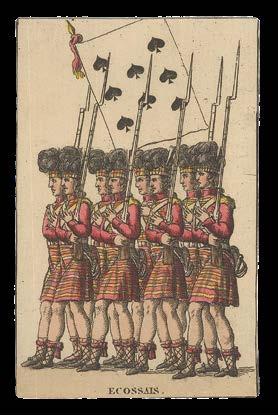
STEIGER, Joh[an] G[eorg]
[Industrie und Glück tarot cards].
Publication
Vienna, J. G. Steiger, [1827].
Description
52 engraved playing cards, with blue pattern to verso, tax stamp to Ace of Hearts.
Dimensions
104 by 56mm (4 by 2.25 inches).
£4,000
Industrie und Glück
The Makers
Johan Georg Steiger took over the firm of J. R. Hoffmann at Breuner Strasse No. 1132, Vienna, from which he produced and sold playing cards throughout the 1820s, 1830s and 1840s. Steiger published several decks of tarot cards, including one allegorical deck and one Industrie und Glück deck, as here.
The Cards
Industrie und Glück (Diligence and Fortune) decks were developed in the nineteenth century in the Austro-Hungarian Empire for playing tarock. Using the French suits of Clubs, Diamonds, Hearts and Spades, the King, Queen and Jack are accompanied by a Cavalier; in the red suits, cards Five to Ten are removed, and in the black, cards Ace to Six. 22 trump cards are added for a total of 54, making the deck quite unlike any other. Apart from the court cards, which have double-figure characters, the cards are illustrated with scenes of rural life, with VII here showing a woman fishing on one half and a picnic scene on the other. These cards all have their values identified with large Roman numerals.


54 DANIEL CROUCH RARE BOOKS EVERY HAND’S A WINNER
23


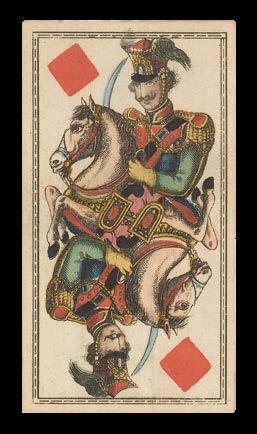

Mademoiselle
[Anonymous]
Grand Jeu de Mlle Normand.
Publication
Paris, B.P. Grimaud, Chartier Marteau & Boudin, 1845.
Description
54 chromolithograph cards, with tax stamp on Ace of Clubs, with green pattern to verso, with original paper booklet, housed in original box.
Dimensions
128 by 90mm (5 by 3.5 inches).
£2,000
The Maker
Renowned French bookseller, necromancer, fortune-teller and cartomancer, Marie Anne Le Normand, rose to considerable fame during the Napoleonic era. It is believed that she issued premonitions of death to Marat, Robespierre and Saint-Just, and that Empress Joséphine and Napoleon Bonaparte consulted with her. There is no indication that Mademoiselle Le Normand actually designed or used the present cards, but her name no doubt lent a certain mystique to the deck. They were published in 1845 by the firms of B.P. Grimaud and Chartier Marteau & Boudin in Paris. B.P. Grimaud & Cie. was founded in 1848 as a small playing card factory in Paris, producing decks on a range of themes and subjects. The firm continued to prosper throughout the subsequent century, and in 1962 was bought by a larger company, Ducale-France Cartes. Marteau & Boudin was a manufacturers based at 54 Rue de Lancry which generally worked in association with Grimaud.
The Cards
Characterised by a complex suite of mythological, astrological and alchemical iconography, the Grand Jeu de Mlle Lenormand was designed as a tool for divination. Each card has a central image with two or three smaller illustrations beneath it, which are to be interpreted by the user. The images are based on a variety of themes including the stars, Greek mythology, botany, the alphabet or the standard playing cards. The Eight of Spades, for example, has a miniature version of the card itself in the upper left-hand corner, a bold black “M” on the opposite side; the main image shows Achilles dragging the body of Hector around the walls of Troy, with a certain constellation adorning the skies above. Beneath this are three further images of a tombstone, a small bouquet of simple flowers, and a skull and cross-bones. The accompanying booklet, entitled ‘Grand Jeu de société et pratiques secrètes de Mlle Le Normand’, provides some interpretations of the elements shown and explains how the deck can by used for “past-present-future fortune-telling”. The same deck of cards was also published in Great Britain under the title ‘Grand Jeu Lenormand Astro Mythological Cards’.
56 DANIEL CROUCH RARE BOOKS EVERY HAND’S A WINNER
24
Le Normand’s divination deck


GILBERT, O.
[Cartes Parisiennes].
Publication
[Paris, O. Gilbert, c1850].
Description
52 engraved playing cards with fine original hand-colour.
Dimensions
86 by 56mm (3.5 by 2.25 inches).
£2,000
Parisian Chic
The Maker
Parisian card-maker O. Gilbert, whose company was located on the Rue des Signes 3, became known for the production of cards with characters in beautiful costumes.
The Cards
Gilbert sold a number of decks under the title ‘Cartes Parisiennes’, with several different editions made, among them a more exclusive deck with gold print. These cards have come to be known as “costume decks” for the obvious reason of their characters’ wonderful clothing. Here, the Jacks of Clubs and Spades are dressed ready for the hunt, while the other male court figures are all in clothing typical of the aristocratic upper classes from the nineteenth century. The Queens are dressed in huge dresses, with the Queens of Spades, Diamonds and Hearts carrying fans, and the Queen of Clubs a flower. Some of the figures appear on the court cards of other decks by Gilbert, often in different suits.
On the Kings and Queens, the name of the figure shown is mentioned at the bottom of the card:
Clubs – Bussy d’Amboise, Dame de Monsoreau
Diamonds – Cinq Mars, Marion Delorme
Hearts – Chev[ali]er D’Éon, C[omp]tesse de Rochefort
Spades – C[omp]te de Brissac, Diane de Poitiers
The pip and Ace cards are presented simply with the number of suit marks shown corresponding to the value of each card.
58 DANIEL CROUCH RARE BOOKS EVERY HAND’S A WINNER
25
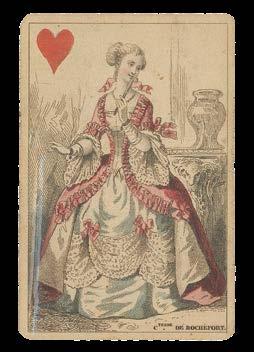

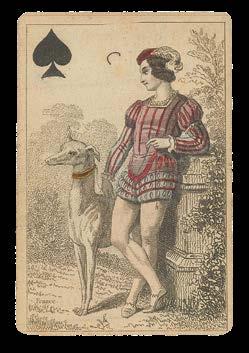

JÄGER, Lud[wig] Jos[eph]
[Hungarian Tarock deck from Slovakia].
Publication
Pressburg, [c1850].
Description
42 engraved playing cards, with red pattern to verso, two black tax stamps to Skiz.
Dimensions
100 by 52mm (4 by 2 inches).
£5,000
Slovakian playing cards
The Maker
The Jack of Clubs is bearing a plate which the name of the maker is given: “Lud. Jos. Jäger” of Pressburg, now Bratislava. Other extant cards by Jäger show that he produced decks in a variety of formats, using French and German suit systems. The Skiz card in the present deck has two tax stamps, which were in use between 1850 and 1856, providing a mid-nineteenth century date for these cards.
The Cards
The Hungarian varient of the Tarock family of card games originated in nineteenth century from an Austrian version. It is thought that the 48 points required to win the game may be a reference to the 1848 Hungarian Revolution, suppressed by the Russians under Ivan Fyodorovich Paskevich, after whom the game is sometimes known as ‘Paskievics’. The Hungarian Tarock deck is made up of trumps (I to XXI, and a Skiz, or Fool), court cards of King, Queen, Cavalier and Jack, and in the black suit a 10 pip card, while in the red an Ace. The present deck was made by a Slovakian card-maker in Bratislava, which was then part of the Austrian Empire, and soon after the Austro-Hungarian empire.
The court cards are double-figures and traditionally dressed in royal garb. The trump cards, with the exception of the Skiz, which shows a double-figure character holding symbols and the I, which depicts a double-figure mandarin character, all show double-sided illustrations of famous and important buildings and places within the Austrian Empire. Card VII, for example, shows a vista of Baden on one side, and Schönbrunn Palace on the other.
60 DANIEL CROUCH RARE BOOKS EVERY HAND’S A WINNER
26
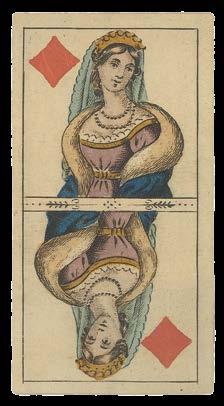



The García design
GARCÍA, Raimundo
[Spanish woodcut deck].
Publication
Torrecilla de Cameros, Señora Pinillos de Vallejo, [c1855].
Description
40 woodcut printed playing cards with original hand-colour, with original printed wrapper.
Dimensions
90 by 58mm (3.5 by 2.25 inches).
£1,600
The Maker
During the second quarter of the nineteenth century, Raimundo García designed and produced playing cards in Madrid, bringing out a unique design which maintained his reputation throughout the remainder of the century. García often delegated production of his cards to other workshops, meaning that similar decks are found from a variety of makers, albeit giving credit to the original designer. The present deck names both García and the manufacturer, Señora Pinillos de Vallejo, whose imprint appears on the Four of Cups. Pinillos de Vallejo took over the family business in 1852 after the death of her husband, Manuel Maria de Vallejo, whose name is also found on the wrapper of this deck. Under her direction, the business continued to operate for the next two decades.
The Cards
García’s deck naturally follow the Spanish suit system of clubs, coins, cups and swords. Among the hallmark elements of his prolific design are: full-length court cards, with Kings displaying ankles and feet, and holding their suit marks; hemispherical cups similar to those in the standard Catalan deck; an Ace of Coins with central wreath enclosing shield with a simple ribbon above and below. Here this Ace of Coins contains a Roman-style cameo, and interestingly, the ribbon above and banner below are empty, though coloured. The pip cards have their value represented by a corresponding number of suit marks, with the Aces incorporating a larger design, and the Four of Coins depicting the Spanish coat-of-arms at its centre.
62 DANIEL CROUCH RARE BOOKS EVERY HAND’S A WINNER
27
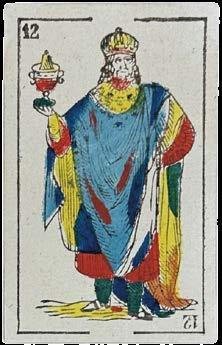



F[ROMMANN], M[aximilian]
Jean Hachette - Jeu à Transformation.
Publication [Darmsdadt], M[aximilian] F[rommann], [c1860].
Description
52 chromolithograph playing cards, blue and white pattern to versos.
Dimensions
90 by 65mm (3.5 by 2.5 inches).
£1,200
A hatchet job
The Maker
Although ‘Jean Hachette’ cards were published around the same time by the Grimaud firm in Paris and Braun & Schneider in Munich, this original deck was made by Frommann and can be identified by his initials on the Eight of Diamonds, as here. Maximilian Joseph Frommann (1813-1866) was an illustrator and card-maker based in Darmstadt, Germany. After his death, his daughter Anna started a publishing business with her husband Georg Bünte, under the name Frommann & Bünte, while his son Friedrich formed his own firm with Friedrich Morian, named Frommann & Morian. From 1866 to 1872, the siblings worked together to manage their late father’s affairs, and later both went on to publish their own decks of playing cards.
The Cards
Published under the title ‘Jeanne l’Hachette’, the present deck of cards is loosely centred around the siege of Beauvais, which occurred in 1472. The daughter of a peasant, nicknamed after her weapon of choice, Jeanne l’Hachette defended her city from the troops of Charles the Bold, Duke of Burgundy. Jeanne herself is shown on the Queen of Spades, axe in hand. The other court cards show a range of single-figure characters, some from the story and some quite unrelated.
The pip cards are examples of the transformation style that was growing in popularity during the nineteenth century. They are more simplistic than earlier examples, with the suit marks incorporated into the image while still retaining their characteristic shapes. The light-hearted illustrations, which often include a dose of humor, show a stark contrast with the more stiff and formal German cards of the time.
64 DANIEL CROUCH RARE BOOKS EVERY HAND’S A WINNER
28

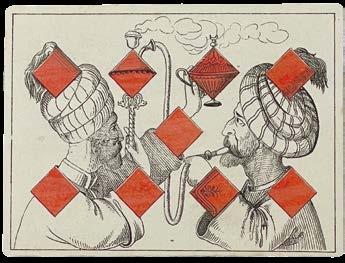
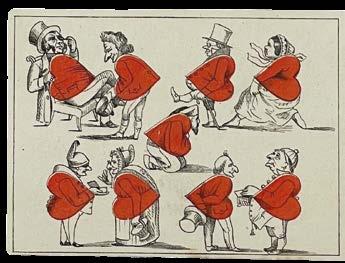
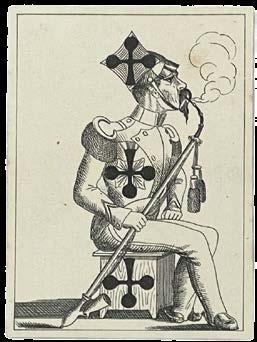
PIATNIK, Ferd[inand]
Narrentarock.
Publication
Vienna, Piatnik, [c1860].
Description
50 of 54 engraved playing cards.
Dimensions
106 by 60mm (4.25 by 2.25 inches).
£1,800
Play the fool
The Maker
Born in Hungary, Ferdinand Piatnik bought the card company of Anton Moser in 1843, transforming it into one of the most successful manufacturers in the world. Between 1843 and 1882, the firm operated under the name ‘Ferdinand Piatnik vormals [‘formerly’] Anton Moser’, and from 1882 onwards became ‘Ferdinand Piatnik & Söhne’. The company continues today as Austria’s largest producer of games.
The Cards
Piatnik’s caricature tarot cards appear to have been directly inspired by the satirical weekly newspaper, Kikeriki, founded in 1861, which ruthlessly mocked the bureaucracy, church, military, industry, trade and government. Many of the stock characters that appear on the 21 non-court cards, including Napoleon as a hunchbacked dwarf, had previously appeared as caricatures in the magazine. There are also a number of ‘fool’ cards that appear also in Piatnik’s ‘Feinsten Wiener Tarock’ deck; among these is the “Dangerous Fool” (II), depicted as an owl wearing a black priest’s coat and sporting a red crab’s tail, a “Funny Fool” (XIV), represented as a rooster with a whip, the symbol of the Kikeriki newspaper, and the “Drunken Fool” (XVIII), portrayed as King Victor Emmanuel II drinking from the Italian boot labelled “Vino d’Italia”. The value of each of these cards is given along the upper- and lower-edges in large Roman numerals. The court cards, by contrast, are fairly typical double-figure Kings, Queens and Jacks, the Jack of Hearts bearing the publisher’s imprint.
66 DANIEL CROUCH RARE BOOKS EVERY HAND’S A WINNER
29

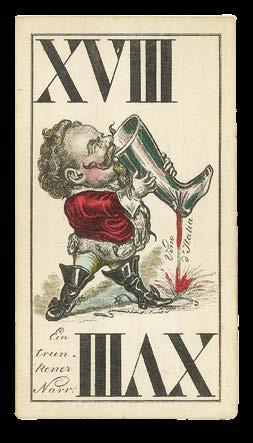
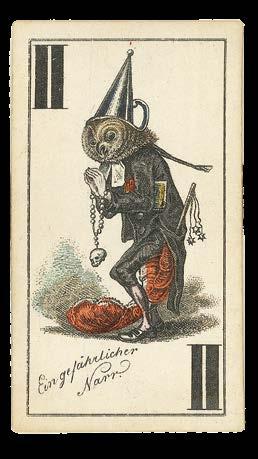
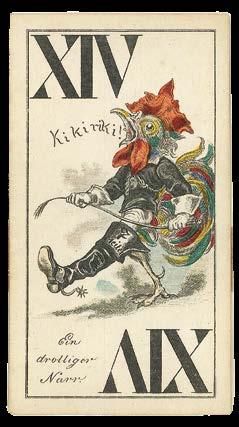
American Card Company
National Emblems.
Publication
[New York, American Card Company, 14 Chambers St. & 165 William St., 1862].
Description
52 chromolithograph playing cards, housed in original slipcase lacking upper half, with publisher’s sticker and stamp to lower half.
Dimensions
90 by 65mm (3.5 by 2.5 inches).
£3,000
The Ace of Eagles
The Maker
In 1862, Benjamin W. Hitchcock registered a new deck of cards made by his American Card Company with the New York Clerk’s Office. Hitchcock owned a publishing firm at 14 Chambers St., New York, producing sheet music, books, musical instruments, printing presses, and type. It appears that the ‘American Card Company’, however, may have been established purely to produce this deck of cards during the Civil War, of which Hitchcock also seems have considered himself an expert, publishing his own book four years later: ‘Hitchcock’s chronological record of the American civil war’.
This deck seems to have been distributed in North East America exclusively by the Bufford lithography house in 1863. John Henry Bufford was a lithographer based in Boston, Massachusetts from 1829 to 1870. His output was varied, producing sheet music, views, illustrations and portraits. Bufford’s sons took over the firm after his death, expanding the enterprises to the nearby major cities of New York and Chicago. The stamp on the slipcase here identifies the printers as “Bufford’s Print Publishing House”; although the firm does not ever seem to have had this as its official name, other publications from the 1860s also bear this imprint.
The Cards
Designed for Union Army soldiers and their families, Hitchcock was “confident that the introduction of National Emblems in the place of Foreign, in Playing Cards, will be hailed with delight by the American People, take pleasure in presenting the Union Playing Cards as the first and only Genuine American Cards ever produced, in the fullest confidence that the time is not far distant when they will be the leading card in the American market”.
The traditional French suits have been replaced with Eagles, Shields, Stars and Flags, and the court cards now show identical Colonels, Goddesses of Liberty, and Majors in the place of Kings, Queens and Jacks. The Ace of Eagles is the only pip card with an illustration, depicting an eagle perched, wings spread, atop an empty cage, bearing in its mouth a banner reading “de pluribus unum”, the traditional motto and animal of the United States.
68 DANIEL CROUCH RARE BOOKS EVERY HAND’S A WINNER
30

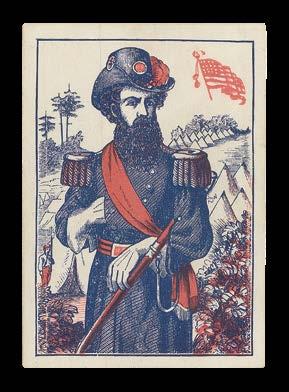
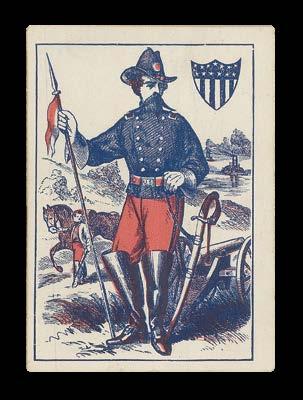
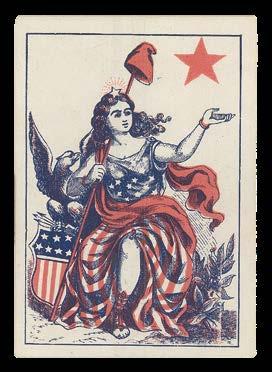
WILNER, J[osef]
[Hungarian Tarock cards].
Publication
Budapest, Spielkarten Fabriks Actien Gesellschaft, 1865.
Description
40 engraved playing cards, with green pattern to verso, tax stamp to Ace of Hearts.
Dimensions
100 by 56mm (4 by 2.25 inches).
£1,200
Don’t hurt the Hungarians!
The Maker
Josef Wilner, whose name appears on the Jack of Diamonds, was a cardmaker who became prominent in Pest during the revival of playing-card production in the city following the Habsburg supression of the Hungarian revolution. With several decks by Wilner extant today, he seems to have made cards following a range of themes, including a pack designed for children.
The Cards
The Hungarian varient of the Tarock family of card games originated in ninteenth century from an Austrian version. It is thought that the 48 points required to win the game may be a reference to the 1848 Hungarian Revolution, supressed by the Russians under Ivan Fyodorovich Paskevich, after whom the game is sometimes known as ‘Paskievics’. The Hungarian Tarock deck is made up of trumps (I to XXI, and a Skiz, or Fool), court cards of King, Queen, Cavalier and Jack, and then in the black suit a Ten pip card, while in the red an Ace. The present deck is lacking the two Tens of Clubs and Spades.
The court cards are double-figures and traditionally dressed in royal garb, and the Skiz shows a double-figure jester-like character holding a baton that reads “ne bántsd a magyart” (’Don’t hurt the Hungarians’), perhaps a reference to the recent revolution. Interestingly, the Jack of Diamonds holds an open book on which it is written, along the maker’s name, “legfino kártya” (‘nicest card’). The numbered trump cards all show double-sided illustrations of rural scenes and figures. On the XIV, women are shown washing garments, on one side in a stream, and on the other in a wooden basin; on the XV, men water animals, the upper image showing a man allowing his horses to drink from a well, and the lower leading cows to a trough.
70 DANIEL CROUCH RARE BOOKS EVERY HAND’S A WINNER
31
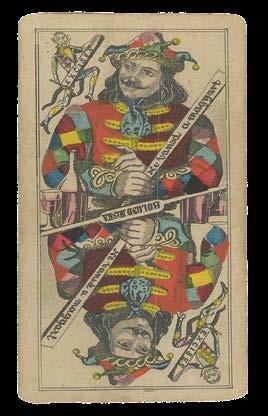
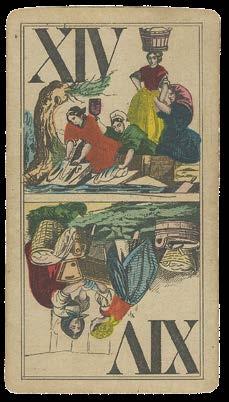
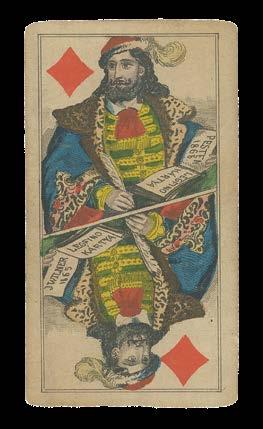

WEGENER, T[heodore] [and] L[udwig] HEIDBORN
[German deck with vignettes and ancient gods].
Publication [Stralsund], T. Wegener [and] L. Heidborn, [c1870].
Description
32 engraved playing cards, with black diagonal pattern to verso, tax stamp to Four of Hearts.
Dimensions
100 by 58mm (4 by 2.25 inches).
£1,200
Pastimes, professions and pastoral pursuits
The Makers
The publisher’s imprint on the Four and Eight of Hearts reads ‘Vereinigte Stralsunder Spielkarten Fabriken Actien Gesellschaft Stralsund’. Vereinigte Stralsunder was the name the Altenburg printing firm operated under after merging with two other local playing card companies in 1872. Altenberg cards became well-known for their good quality and value. The business changed hands numerous times throughout the following century, and remains active today as a market leader of German playing cards.
The Knave of Hearts has inscribed on the side ‘früher L. v. d. Osten, L. Heidborn. T. Wegener’ and, on the bottle of beer held by the doublefigure character, ‘Stralsunder 8s. g.’. Thus it seems that Ludwig Heidborn and Theodore Wegener had taken over the earlier business of one L. V. d. Osten, and were producing playing cards in Stralsund during the latenineteenth century, before their firms were brought together under the Altenberg company.
The Cards
Using the traditional German suits of Acorns, Bells, Hearts and Leaves, the pip cards seems to be thematically arranged. In addition to the suitmarks, the number of which correlates to the value of the card, each one shows a small vignette, those on the Acorns and Bells associated with professions and pastimes, the Hearts and Leaves with rural pursuits. For example, the Seven of Acorns shows a dentist extracting a patient’s tooth, and the Ten a fencing match; together the Seven and Eight of Leaves depicts a stag hunt, while the Nine of Hearts shows a fisherman with a large catch.
The court cards show double-figure male characters, who descend in rank from the King, suitably dressed in royal garments, to the Over Knave, formally dressed and three of whom carry some form of weapon, to the Under Knave, three of whom bear a mundane item: a beer bottle, a pheasant and a tablet. On the Four of each suit is a double-figure representation of a different ancient pagan god of goddess: on the Four of Acorns Dionysus, the Four of Bells Demeter, the Four of Hearts Athena and the Four of Leaves Artemis.
72 DANIEL CROUCH RARE BOOKS EVERY HAND’S A WINNER
32
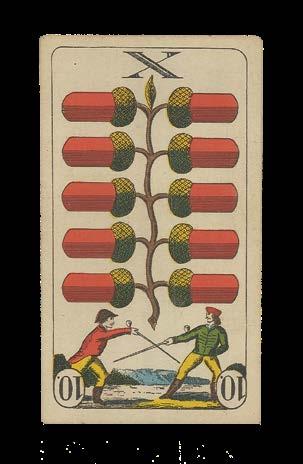


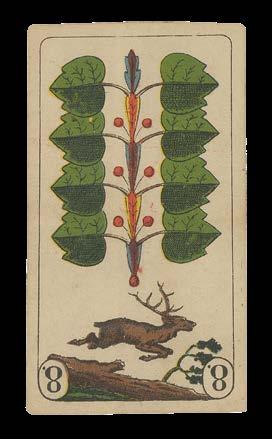
Deckfest at Tiffany’s
CARRYL, C.E.; TIFFANY & CO.
Harlequin cards.
Publication
New York, Tiffany & Co., [1879].
Description
52 engraved playing cards with fine original hand-colour, with blue ink stamp to Ace of Hearts, with tartan plaid pattern with mounted harlequin medallion to verso, with gilt edges.
Dimensions
96 by 66mm (3.75 by 2.5 inches).
£2,000
The Maker
Hailed as the American Lewis Carroll, Charles Edward Carryl turned children’s writer after decades working in business. His illustrated adventure stories and nonsense poetry, which feature the ‘Walloping Window Bird’, certainly seem starkly different from the New York Stock Exchange! In addition to writing, Carryl also designed the present deck of cards for Tiffany & Co., displaying the same whimsy that characterised all his artistic output. It is not clear for what occasion or event the renowned jewellery house commissioned this unique souvenir. By the time of his death in 1920, Carryl’s work had shown that children’s nonsense writing was no longer solely the domain of British authors such as Carroll and Lear.
The Cards
Carryl’s cards, which continue the earlier European tradition of the transformation deck, are considered perhaps the most skilful and imaginative example of the style to be produced in America. As defines transformation decks, the pips have become part of the design, with the hearts on the Seven of Hearts appearing as the faces of “A Batch of Barristers”, and the five diamonds on the corresponding card serving as the hats of “The Begora Brigades”. The court cards too, although they do not have their suit symbols incorporated into the design, are equally amusing. The King of Diamonds is blithely playing a banjo, while the Queen of Clubs seems to be a little tipsy!
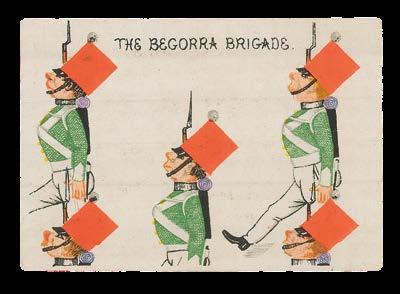
74 DANIEL CROUCH RARE BOOKS EVERY HAND’S A WINNER
33
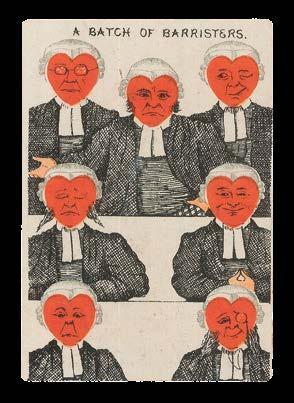
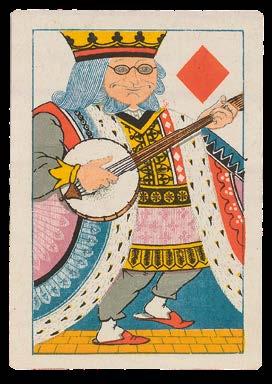

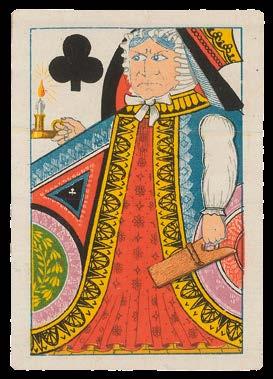
The only French game played with Spanish suits
[ANONYMOUS]
Jeu de l’Aluette [or] Cartes des Pêcheurs.
Publication
Paris, B.P. Grimaud, [c1880-90].
Description
48 woodblock printed playing cards with fine original hand-colour, black pattern to versos.
Dimensions
87 by 57mm (3.5 by 2.25 inches).
£450
The Maker
The Ace of Coins shows an illustration of a castle within a circular cartouche surmounted by an eagle; beneath this is a banner reading the publisher’s name: “B. P. Grimaud”. In 1848, Baptiste-Paul Grimaud established a small playing card factory in Paris, producing decks on a range of themes and subjects. The firm continued to prosper throughout the subsequent century, and in 1962 was bought by a larger company, Ducale-France Cartes. It continues today as part of the Cartamundi Group. The designer of this particular deck is not known.
The Cards
Perhaps imported to France by neighbouring Spanish sailors, or simply born in western France in the sixteenth century from the only playing cards then available, the game of aluette, also known as Jeu de la Vache or Cartes des Pêcheurs, is the only French card game to be played with the Spanish suit system of clubs, coins, cups and swords.
Played by four people in two teams with 48 cards, Aluette is a strategy game that includes codified signs with which teammates communicate information about their cards during the game. First mentioned in 1532 as “luette”, the game is traditionally played in the rural and coastal areas between the Gironde and the Loire estuary.
The present example of an aluette deck is highly illustrative: although the pip cards of higher value are generally represented with the corresponding number of coloured suit marks, the Aces, court cards, and lower value pip cards tend to incorporate some sort of design. The court cards show full-length royal figures in various poses that incorporate their suit mark: the Jack of Coins reaches out for a large golden disk, while the Queen of Swords brandishes one while riding a horse. The Aces all feature an elaborate design centred around a single large club, coin, cup or sword, and the Deuces, Threes and Fours likewise show illustrations, such as the Three of Cups, which depicts three tall vases filled with fruit, foliage and, bizarrely, a female bust.
The Bibliothèque nationale de France holds a copy of the deck with a different pattern to the verso, which it dates to 1858, suggesting that the present deck may be from a later edition of Grimaud’s aluette cards.
76 DANIEL CROUCH RARE BOOKS EVERY HAND’S A WINNER
34

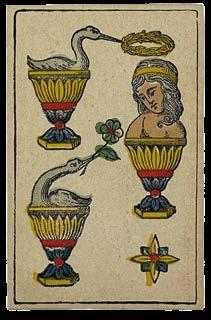
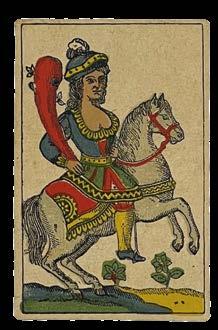
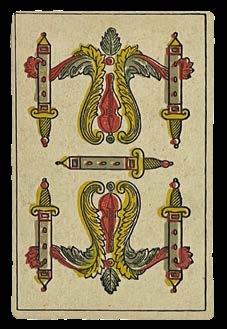
? FRERES
[Jeu de cartes par demandes et par réponses].
Publication
Paris, David, [1880-1890].
Description
24 engraved playing cards with pink hand-colouring.
Dimensions
82 by 50mm (3.25 by 2 inches).
£800
“Will you be faithful?”
The Maker
The card bearing the answer “d’en doubte” has the publisher’s imprint inscribed on the upper right-hand side of the card: “David, Paris”, while a question card reading “avez vous bon caractere” may bear the name of the maker, although it is illegible.
The Cards
Popular during the nineteenth century in France, question-and-answer card games were divided into suitably generic inquiries and responses to allow players to create a variety of funny combinations. In the present deck the questions and answers are combined with caricature stock-characters for greater comedic effect.
To the matronly figure asking “Serez-vous fidèle” (‘will you be faithful’), for example, players could choose a range of responses, “d’en doute” (‘doubtful’), said by a stern-looking man in a bow tie, to “quelquefois” (‘sometimes’), according to a mischievous man in a round hat. Those cards that bear responses have their writing highlighted in pink, while those with answers are uncoloured; on all cards, pink is used to highlight aspects of the caricatures dress or appearance.


78 DANIEL CROUCH RARE BOOKS EVERY HAND’S A
WINNER
35
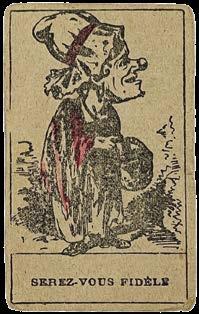

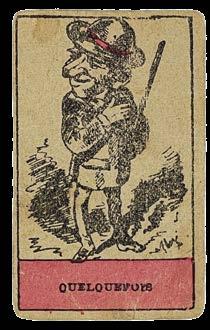
 GLANZ, Jos[eph]
GLANZ, Jos[eph]
[Bohemian pattern deck].
Publication
Vienna, Joseph Glanz, [c1885].
Description
32 engraved playing cards, with red and black pattern to verso, tax stamp to Eight of Bells.
Dimensions
100 by 60mm (4 by 2.25 inches).
£1,200
The Bohemian pattern
The Makers
Joseph Glanz was a carpenter, medalist and printer, who is considered a founding figure of Vienna’s artistic heritage. During his career, he produced numerous decks of cards, with a wide range of themes and styles. His company eventually acquired the firms of Max Uffenheimer and Johann Ritter & Cie, but was in turn absorbed by Piatnik in 1912.
The Cards
Sometimes known as the Prager pattern, the Bohemian pattern for playing cards is related to the more common Bavarian deck, with Acorns, Bells, Hearts and Leaves as the suits. It is distinguished, however, by its court cards, which show Knaves, two in each suit, separated into military divisions and thus holding spears, halberds, swords and musical instruments, respectively, while the Kings are seated with two suitmarks above each.
Bohemian pip cards have their values represented by the corresponding number of suitmarks, and always have small vignettes along the lower edges showing rural or natural scenes, objects, animals or figures. Here the Eight of Leaves has an elephant beneath the suitmarks, while the Seven of Hearts shows a shrub flanked by flowers. The Aces each bear a large and striking design, with the Ace of Bells depicting the AustroHungarian coat of arms, and the Ace of Acorns Glanz’s imprint above a wild mythical cat, clutching the Hapsburg double-headed eagle in its left paw, and architectural view in its right.
80 DANIEL CROUCH RARE BOOKS EVERY HAND’S A WINNER
36

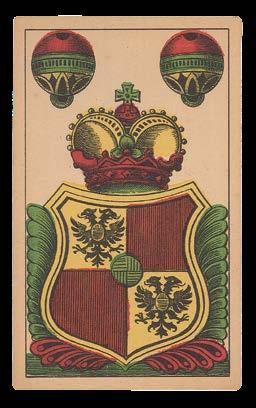
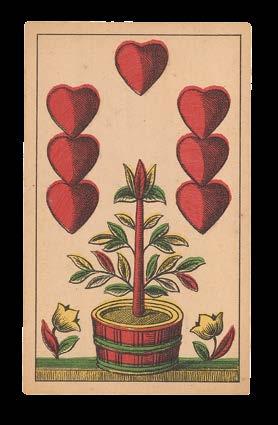

Cards fit for a king
BURGER, Ludw[ig]
Deutsche Spielkarte von 36 Blatt.
Publication
Leipzig, T[heodor] O[swald] Weigel, [1885].
Description
36 chromolithograph playing cards, with blue pattern to verso with imperial crest.
Dimensions
100 by 64mm (4 by 2.5 inches).
£600
The Makers
German painter and illustrator Ludwig Burger produced a wide variety of work, from illustrations for the works of La Fontaine to the ceiling murals of Berlin City Hall. Active from the 1850s to the 1880s, Burger had occasion to present his work at a number of historic events, including the silver wedding anniversary of Crown-Prince Friedrich-Wilhelm, later Friedrich III of Germany, and his wife Victoria, eldest daughter of Queen Victoria of Great Britain.
The Cards
The cards present the themes thought suitable for the future king, who admittedly would rule for just 99 days, with the Acorns illustrating the art of warfare, Bells craft, industry and commerce, Hearts love, and Leaves hunting. The three masculine court cards shown full-length figures with the Kings seated while the Ober and Unter executing tasks associated with their suit’s theme. On the pip cards, the value is shown by the number of suitmarks, and is also written in German along the upper and lower edges. Various figures, animals and plants decorate the cards.
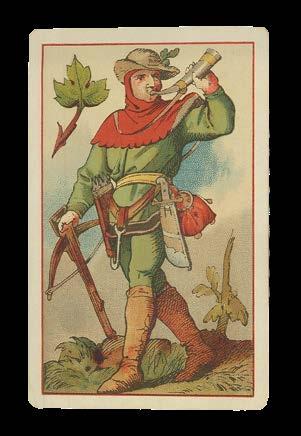
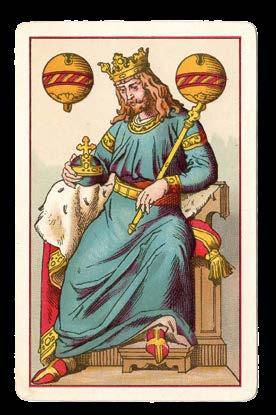
82 DANIEL CROUCH RARE BOOKS EVERY HAND’S A WINNER
37

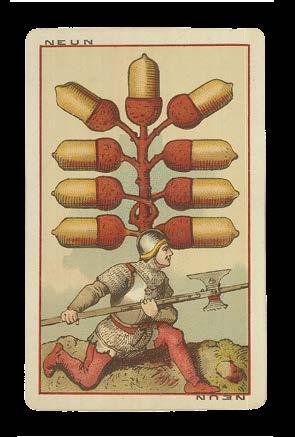

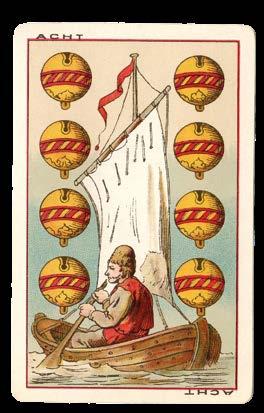
Playing Politics
DEAKIN & CO.
Deakin’s Political Playing Cards.
Publication
London, [W.H. Willis & Co., 1886].
Description
52 engraved playing cards in original yellow cardboard case, with damage to case.
Dimensions
90 by 64mm (3.5 by 2.5 inches).
£1,200
The Maker
The box advertises that the cards “may be had of Deakin & Co. Original Style Printers [at] 45 Eastcheap, London”. The only materials attributed to these printers, however, are the three editions of this deck of cards. It seems that, rather than printers, Deakin & Co. was in fact a wholesale stationers, and their playing cards were printed by W.H. Willis & Co., a company formed in 1869 which produced a huge variety of playing cards until 1892.
The Cards
Advertised as being “Suitable for Whigs, Tories, Radicals, and Home Rulers”, this deck was made in the wake of the political turmoil happening at the time. With the role of Prime Minister filled by alternately the Conservative Disraeli and Liberal Gladstone since 1868, Robert Gascoyne Cecil, 3rd Marquess of Salisbury emerged as the new leader in June 1885. Having held the office for little more than six months, he was opposed by the returning Gladstone, with whom he interchanged the top job twice during the course of the next eight years.
While the pip cards are simple playing cards, albeit with miniature versions of the cards themselves in opposite corners, the court cards in this deck reflect the various figures, stances and controversies that gave contemporary politics such memorable (and marketable!) character. The Marquis of Salisbury is depicted as a double-figure on the King of Diamonds, holding a tankerd reading “Cheap Beer”, while Gladstone is portrayed as the King of Hearts, bearing a banner with the slogan “G.O.M.” for ‘Grand Old Man’.
In two years, there were three editions of the cards printed after the first, of which the present deck is an example, sold 60,000 packs in 1886.
84 DANIEL CROUCH RARE BOOKS EVERY HAND’S A WINNER
38
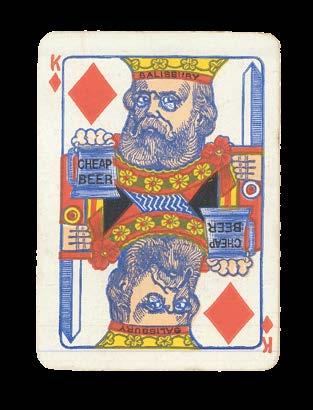
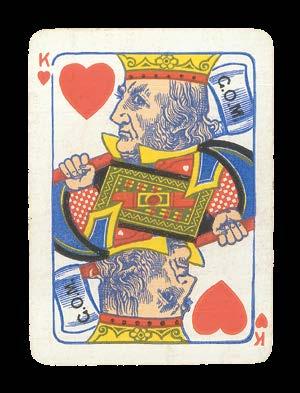

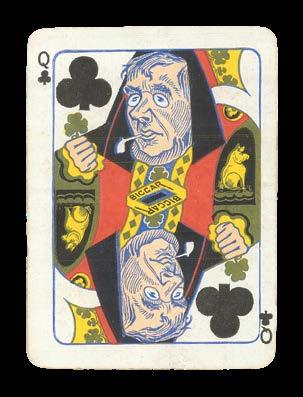
[ANONYMOUS after JeanBaptiste ALLIETTE]
Tarots de Etteilla.
Publication
Paris, B.P. Grimaud & Cie, [c1890].
Description
78 chromolithograph playing cards, with blue pattern to versos, housed in modern case.
Dimensions
118 by 65mm (4.75 by 2.5 inches).
£900
The Tarots de Etteilla
The Maker
Jean-Baptiste Alliette, who went by the pseudonym of Etteilla, was a French occultist and tarot-researcher who published his first book on the mystical subject while working as a seed merchant. ‘Manière de se récréer avec le jeu de cartes nommées tarots’ (1783-85) is still today considered the standard reference work on the subject of tarot cartomancy. Three years later Alliette formed the ‘Société des Interprètes du Livre de Thot’ and soon after the ‘Nouvelle Ecole de Magie’.
In 1789, he published his own deck of tarot cards which differed from the traditional Marseilles deck that had formed the body of much of his research, and which was widely disseminated in various editions throughout the following centuries. The present edition was published by B.P. Grimaud & Cie., which had been founded in 1848 as a small playing card factory in Paris, producing decks on a range of themes and subjects. The firm continued to prosper throughout the subsequent century, and in 1962 was bought by a larger company, Ducale-France Cartes. It continues today as part of the Cartamundi Group.
The Cards
The 78 cards in the present deck replicate the figures, scenes and designs found on the original Etteilla cards, but with smaller illustrations leaving room for captions and numbers to be written in the outer border. Using decks such as this, practitioners of cartomancy formulate questions about the past, present or future, and then select a card unseen to interpret for their answer.
Some cards seem fairly direct, such as 15 - Maladie, 21 - Dissension, and 80 - L’Amour, while the meaning of others is open to interpretation, 16 - Jugement, for example. Many of the cards have two, seemingly opposing, options illustrated and labelled on them: 6 - Nuit / Jour, 25 - Etranger / Nouvelle, 44- Le Passé / Avenir. Also found illustrating many cards are the Minor Arcana, or the suit cards in a tarot deck, descending from the early non-cartomantic game played in Italy from the fifteenth century. The Minor Arcana consist of wands, cups, swords and coins, associated respectively with creativity, emotion, reason and possessions. Other information given on certain cards to aid in their interpretation include the element associated with that card.
86 DANIEL CROUCH RARE BOOKS EVERY HAND’S A WINNER
39
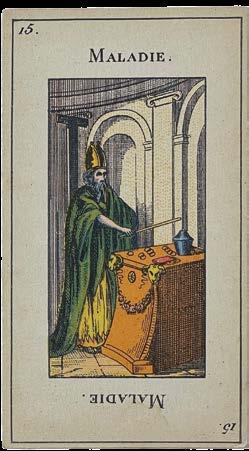
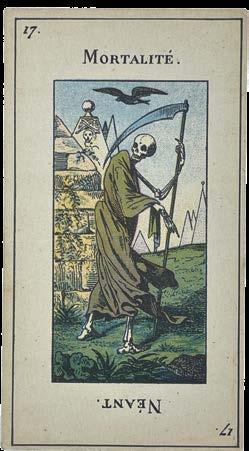
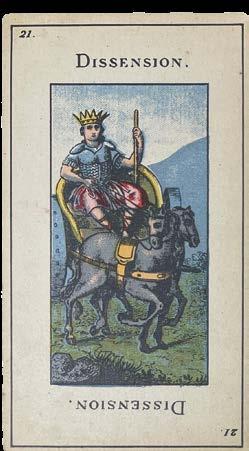
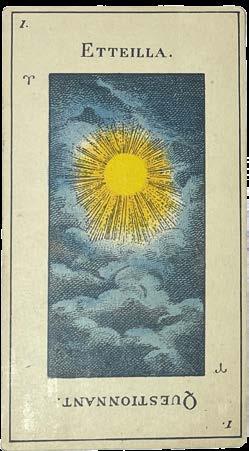
MALDONADO, Pedro
Nueva Baraja Taurina.
Publication
[Madrid, Imp. y Lit. de González, c1890].
Description
40 chromolithograph playing cards, with linear pattern to verso.
Dimensions
95 by 62mm (3.75 by 2.5 inches).
£800
Toréador, en garde
The Makers
Designed by unknown Spanish artist Pedro Maldonado, this deck of cards was printed by the Imprenta y Litografía N. González in Madrid. Active during the later decades of the nineteenth century, the González firm published a wide variety of printed material, including maps, portraits, posters and playing cards.
The Cards
Themed around the bullfight, the suits of the present deck have been adapted so that Coins appear as branding irons emblazoned with the marks of Spain’s most prominent bullbreeders, Cups as famous picadors, Clubs as banderillas, the barbed weapon used by the matador, and Swords have the portraits of notable toreros as their hilts. The Aces of each suit also feature prominent bullfighters of the time, including Lagartijo, Frascuelo, El Gordito, and Currito, while the court cards depict historic toreros, such as Pedro Romero y Costillares.


88 DANIEL CROUCH RARE BOOKS EVERY HAND’S A WINNER
40
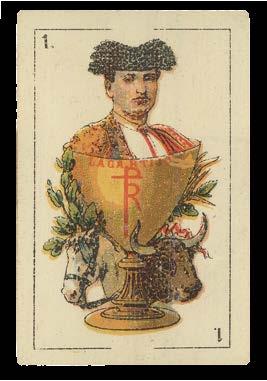
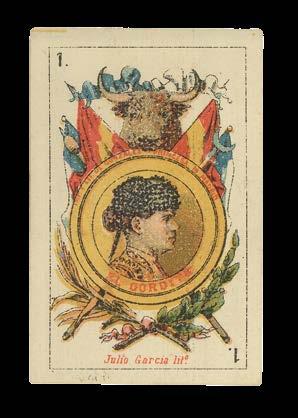
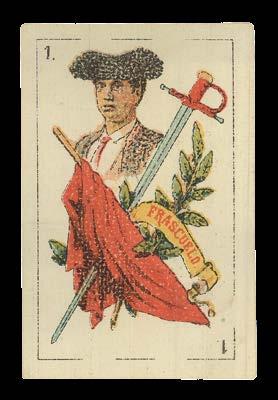
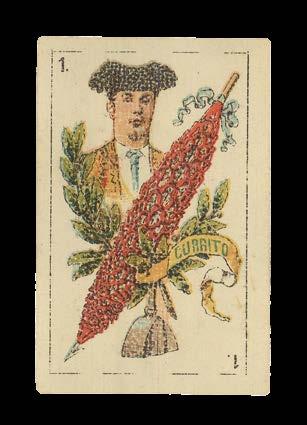
KIMBERLEY, David
Royal National Patriotic Playing Cards.
Publication
Birmingham, David Kimberley and Sons, [1892].
Description
52 chromolithograph playing cards, elaborate printed clock design to versos, housed in original brown slipcase.
Dimensions
91 by 62mm. (3.5 by 2.5 inches).
£500
Patriotic Playing Cards, First Edition
The Maker
Before the publication of their first deck of cards around 1892, David Kimberley & Sons do not ever seem to have worked in the printing or publishing trade. Rather, they were manufacturers of carpenters’ saws and planes in Birmingham. Since there is no direct reference to this business on their playing cards, they do not seem to have been a publicity or advertising stunt. The motivation behind this deck therefore remains something of a mystery, unless it was purely out of “national patriotic” pride!
The Cards
Across a ten year period, Kimberley issued his “National Patriotic” deck in four editions, the present deck being an example of the first, which appeared in December of 1892, ten months after Kimberley had submitted his application to patent his ‘improved playing cards’. Each suit represents a great nation: its Ace bears the national flag and the Court Cards its rulers or leaders, with the Jack depicted as a typical naval soldier:
Clubs - Germany
Diamonds - Britain
Hearts - America
Spades - France
Interestingly, the pip cards show huge suit marks, containing two mirror-image Arabic numerals providing the value. This was one of the features Kimberley had been keen to patent, but was not reproduced in later editions of the deck. Furthermore, the first edition was by far the most luxurious, printer chromolithographically in eleven colours including gold.
90 DANIEL CROUCH RARE BOOKS EVERY HAND’S A WINNER
41


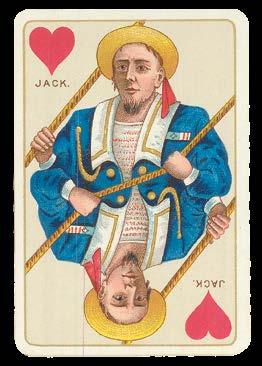
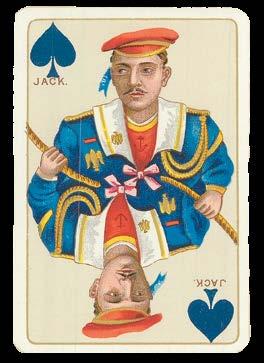
Patriotic Playing Cards
KIMBERLEY, David
Royal National Patriotic Playing Cards.
Publication Birmingham, David Kimberley and Sons, [c1892-1905].
Description
52 chromolithograph playing cards, housed in original orange slipcase.
Dimensions
95 by 62mm (3.75 by 2.5 inches).
£500
The Maker
Before the publication of their first deck of cards around 1892, David Kimberley & Sons do not ever seem to have worked in the printing or publishing trade. Rather, they were manufacturers of carpentry saws and planes in Birmingham. Since there is no direct reference to this business on their playing cards, they do not seem to have been a publicity or advertising stunt. The motivation behind this deck therefore remains something of a mystery, unless it was purely out of “national patriotic” pride!
The Cards
Each suit in Kimberley’s “National Patriotic” deck represents a great nation, its Ace depicting the national flag and the Court Cards its rulers or leaders, with the Jack representing a naval soldier in uniform. On the Clubs is Germany, on Diamonds Britain, on Hearts America and on Spades France.
Across a ten year period, the cards were issued in four editions, the present deck being an example of the second, which appeared from 1893-97. The court cards and aces show the same design as the first edition, but the pip cards are different. While the first edition showed huge suit marks, containing two mirror-image Arabic numerals providing the value, here they are the conventional pip cards, with the number of suit marks conveying the value of the card.
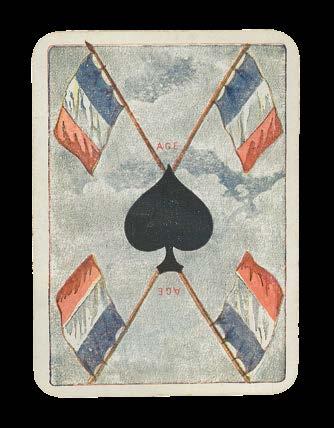
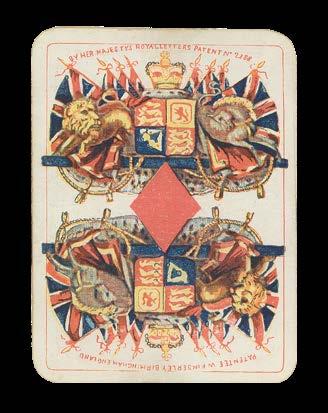
92 DANIEL CROUCH RARE BOOKS EVERY HAND’S A WINNER
42

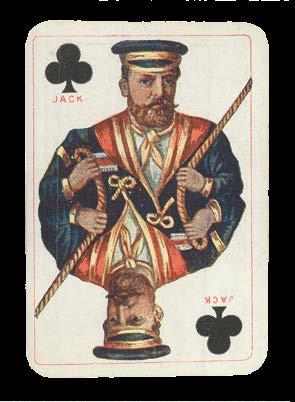
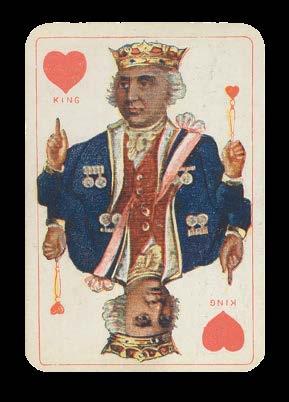
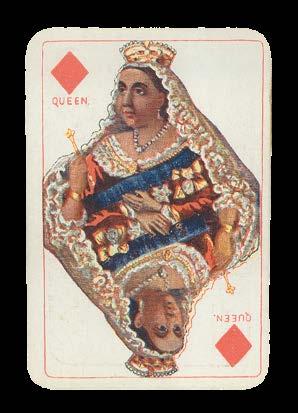
GOODALL, Cha[rle]s
Goodall’s Historic Playing Cards.
Publication
London, Cha[rles]s Goodall & Son, [1893].
Description
52 chromolithograph cards, design to verso, housed in original slipcase.
Dimensions
92 by 64mm (3.5 by 2.5 inches).
£400
English Monarchs
The Maker
Charles Goodall was a playing card maker based first in Soho and later in Camden, where his firm contributed greatly to the development of the area. By 1850, Goodall accounted for approximately two-thirds of playing card produced in Britain and employed over one thousand workers. Among the firm’s most lasting achievements was its pioneering of the double-headed court card design for which, among other innovations and achievements, it was awarded medals at ten different international exhibitions during the nineteenth century.
The Cards
Goodall & Son’s “de luxe” historic playing cards represent four periods of English history:
Club - Plantagenet (1216-1399)
Diamond - Tudor (1485-1603)
Hearts - Stuart (1603-1714)
Spades - Hanoverian (1714-1901)
While the double-figure court cards reflect the contemporary style of the corresponding period, the Kings and Queens do not appear to be direct representations of any particular monarch. The Aces are decorative, with their suit symbol encased within an ornate circular framework. The pip cards are simply represented by the appropriate number of suit symbols, and the Arabic numeral written on opposite corners.

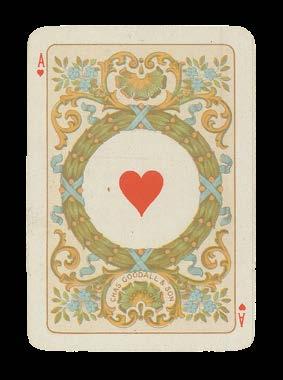
94 DANIEL CROUCH RARE BOOKS EVERY HAND’S A WINNER
43
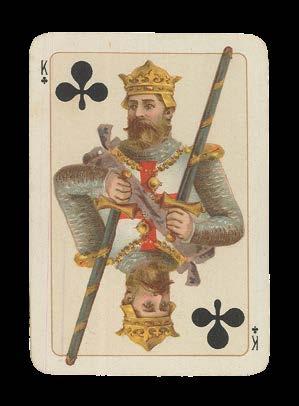
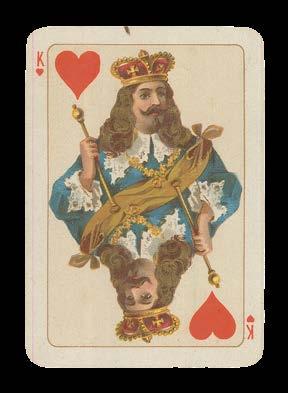

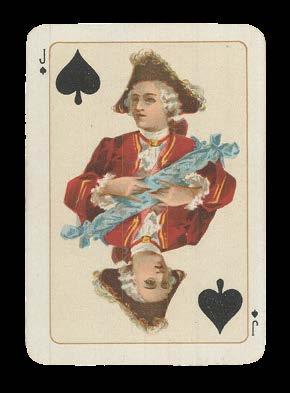
SOLÉ ALSINA, A.
[Children’s Spanish Playing Cards].
Publication
Barcelona, J. Colomer, [c1895].
Description
48 chromolithograph playing cards, with logo to verso.
Dimensions
98 by 64mm (3.75 by 2.5 inches).
£800
The Maker
A. Solé Alsina chocolatiers of Barcelona produced, alongside confectionary, printed material including playing cards and chromolithographic prints. Some of these apparently came as promotional ‘gifts’ alongside their edible wares, and their designs varied widely, with themes including the ‘Popes, Cardinals, Archbishops and Bishops of Europe and America’. J. Colomer is listed in numerous records of the business-owners of late-nineteenth century Barcelona as a printer and bookseller whose sons appear to have taken over the firm towards the turn of the century.
The Cards
The Spanish suits of Clubs, Coins, Cups and Swords have been incorporated into the juvenile theme of the present deck, with the Clubs presented as large skittles and the Coins as balls. On both pip and court cards, the symbols are depicted as toys being played with by children. The Queen of Coins catches a ball in mid-air, for example, while the King of Swords is represented as a boy dressed up in and crown and robe, and brandishing a sword! In addition to the corresponding number of suit marks, the value of each card is written in Arabic numerals on the top and bottom.
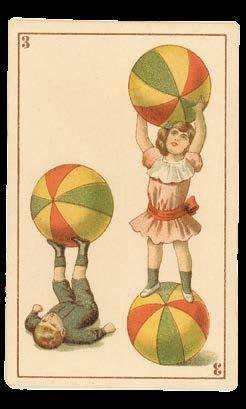
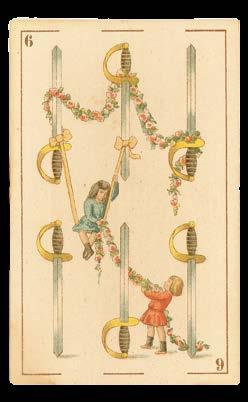
96 DANIEL CROUCH RARE BOOKS EVERY HAND’S A WINNER
44
Vamos niños!
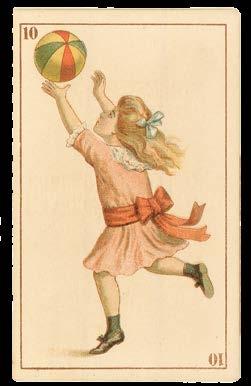

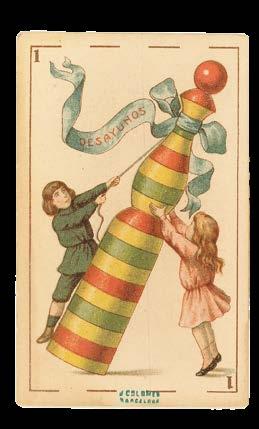
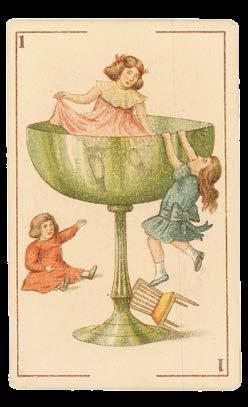
GOODALL, Cha[rle]s
Goodall’s Victorian Playing Cards.
Publication
London, Chas Goodall & Son, 1897.
Description
52 chromolithograph cards, portrait to verso, with advertisement card, housed in original slipcase.
Dimensions
89 by 95mm (3.5 by 3.75 inches).
£400
Diamond Jubilee Cards
The Maker
Charles Goodall was a playing card maker based first in Soho and later in Camden, where his firm contributed greatly to the development of the area. By 1850, Goodall accounted for approximately two-thirds of playing card produced in Britain and employed over one thousand workers. Among the firm’s most lasting achievements was its pioneering of the doubleheaded court card design for which, among other innovations and achievements, it was awarded medals at ten different international exhibitions during the nineteenth century.
The Cards
Produced to mark Queen Victoria’s Diamond Jubilee, this deck has the monarch’s image on the back of every card. The portrait was officially commissioned for the celebration and photographed by London’s leading photographer, Alexander Bassano. As on Goodall’s other historic playing cards, the pip cards are simply represented by the appropriate number of suit symbols, and the Arabic numeral written on opposite corners. The court cards and Aces are dedicated, by suit, to “the Kings and Queens of the previous longest reigns in English History, attired in the costumes of the period.”
Clubs - Edward III, Philippa, Edward
Diamonds - Henry VIII, Elizabeth, Robert Dudley
Hearts - Henry III, Eleanor, Edward
Spades - George III, Charlotte, George
98 DANIEL CROUCH RARE BOOKS EVERY HAND’S A WINNER
45
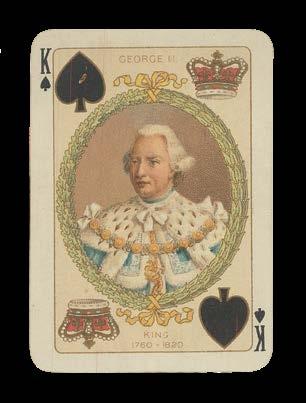

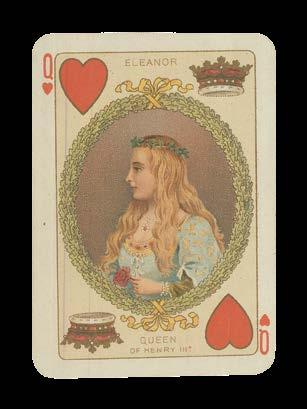
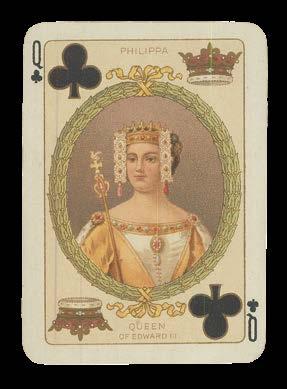
Fair play
[ALTENBURGER
SPIELKARTENFABRIK after Arthur LEWIN]
Leipziger Skat-Karte.
Publication
Leipzig, [Schneider & Co.], 1897.
Description
31 of 32 engraved cards housed in original slipcase.
Dimensions
105 by 65mm (4.25 by 2.5 inches).
£250
The Maker
In 1832, two brothers named Bernhard and Otto Bechstein established a small company in Altenberg for the manufacture of French and German playing cards. Remarkably, the firm made no profit until 1840 due to the immense competition from larger factories in neighbouring states. From 1840, however, Altenberg cards became well-known for their good quality and value. The business changed hands numerous times throughout the following century, and remains active today as a market leader of German playing cards.
Arthur Lewin worked in Leipzig during the late-ninteenth and early-twentieth centuries as a costume designer and illustrator. His art was included in publications, particularly humorous books and articles, and also sold as separate prints. He does not appear to have produced any other decks of playing cards.
The Cards
The first mention of a fair held at Leipzig dates back to 1165, from which point on, no other fair was allowed within a five mile range of the city centre. Trade at these early fairs included herring, cloth, wine and pepper, and rulers including Margrave Theodoric of Landsberg, Frederick II of Saxony and Holy Roman Emperor Maximilian I all took measures to secure its monopoly over other trade fairs. In the 1890s, several fair-houses were constructed in Leipzig, consisting of interconnected courtyards with shops, storage and living spaces, and in 1895, the first commercial sample fair was held there, with exhibitors presenting samples of their goods.
Two years later, the Leipzig Industry and Trade Exhibition celebrated its 400th official anniversary, for which occasion Arthur Lewin created this souvenir pack of playing cards, first printed by Schneider & Co., Altenburg, in 1897. The 32-card deck shows the traditional German suits of Acorns, Bells, Hearts and Leaves, and features the coats of arms of four different noble houses on the four deuces. The pip cards show Lewin’s illustrations of the trade fair, with captions along the bottom of each to help identify the scenes and people shown. The court cards show historical figures, or characters associated with the fair, such as a policeman (Ober of Leaves). The Kings of each suit are presented as rulers relevant with the Leipzig fair:
Acorns - Duke Albrecht of Saxony
Bells - Kaiser Karl V
Hearts - a Medieval Kaiser
Leaves - Margrave Dietrich von Landsberg
In 1997, a facsimile edition was published by Altenburger Spielkartenfabrik to celebrate a further century of fairs.
100 DANIEL CROUCH RARE BOOKS EVERY HAND’S A WINNER
46
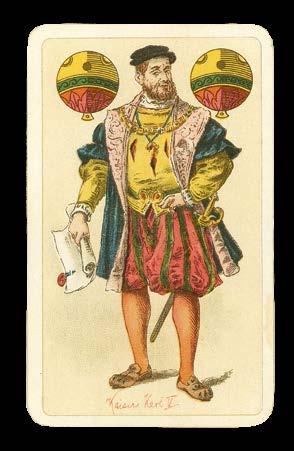
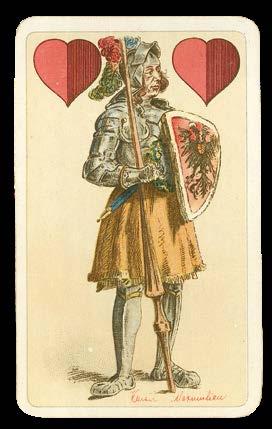
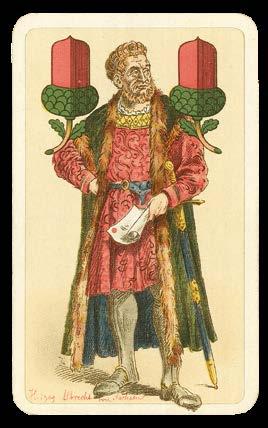
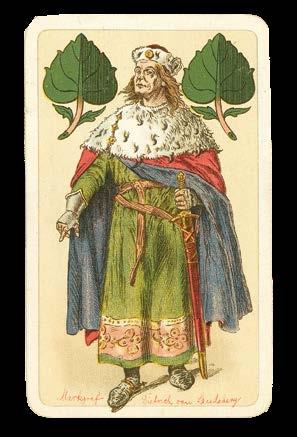
HERWIG, Ferdinand
Vaterländische Spielkarten 1915.
Publication
Goslar, F[ridriech] A[dolf] Lattmann, 1915.
Description
36 chromolithograph cards, black tax stamp to Ace of Hearts, black heraldic design to versos, housed in original slipcase.
Dimensions
94 by 58mm (3.75 by 2.25 inches).
£1,500
German WWI Cards
The Maker
The name of the designer of the present deck, Ferdinand Herwig, appears on the slipcase and the Seven of Diamonds. Herwig was better-known as a painter, and does not appear to have produced any other decks of cards. The present were published by Friedrich Adolf Lattmann, whose name appears to the verso of the case.
In 1794, the prolific Ernst Wilhelm Gottlieb Kircher had transformed his family printing business into a playing card factory. Political upheaval in the following decades meant that the factory was closed, but after its reopening some years later, it was taken over by Friedrich Adolf Lattmann, under whom the company prospered. Lattman produced English, French and German decks centred around a range of themes and subjects. The firm continued to operate until 1929.
The Cards
During the First World War, Lattmann produced two decks of cards around the theme of the conflict, one using the German suits and the other the traditional French, albeit slightly modified, as here, with clubs replaced by crosses. While the pip cards are relatively generic, the court cards show double-figure characters from the war. The Kings represent German leaders:
Clubs - Wilhelm II of Württemberg
Diamonds - Friedrich August III of Saxony
Hearts - Emperor Wilhelm II of Prussia
Spades - Ludwig III of Bavaria
Each of the accompanying Queens is dressed in a typical regional outfit, while the knaves display the uniforms of a variety of military ranks and positions, from seaman to cavalry.
102 DANIEL CROUCH RARE BOOKS EVERY HAND’S A WINNER
47
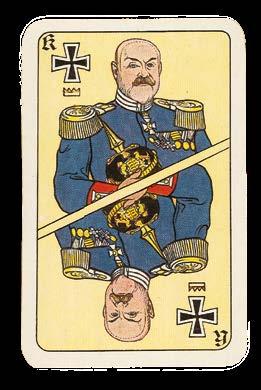
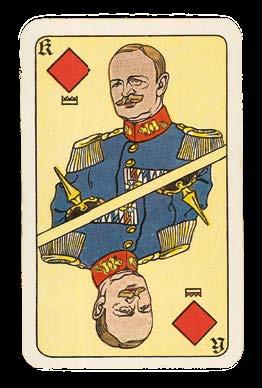
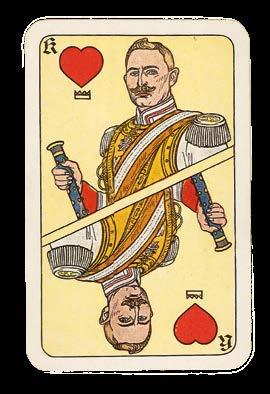

Play that Funke card game
E. FUNKE & CO.
Jass-Karten. Publication
St. Gallen, E. Funke & Co., 1915.
Description
36 chromolithograph playing cards with blue diagonal design to versos, in original paper wrapper.
Dimensions
90 by 55mm (3.5 by 2.25 inches).
£2,000
The Maker
Being active in the 1910s, Swiss publishers E. Funke & Co. produced a number of military-themed decks of cards during the First World War, including the present Jass deck and another Soldatenkartenspiel (’Soldier Card Game’).
The Cards
Known as the national card game of Switzerland, Jass is a trick-taking card games played by two pairs. With 70 variants, the rules can vary, but is always played with a deck of 36 cards, lacking the Two, Three, Four and Five cards found in a 52-card deck. While it is generally played with Swiss-German, Austria or French suits, some decks were made with more unusual suits, as here, with the cards divided into Bullets, Grenades, Horses and Shovels.
These striking suits revolve around the military theme of this deck, in which the court cards depict the Hauptmann (captain), Korporal (corporal) and Oberleutnant (first lieutenant) in the place of the typical royal figures. The inscription of “Grenzbesetzung 1914/1915” (Border occupation 1914/1915) on the Ace of Shovels demonstrates that these cards were made to depict the Swiss army presence along the northwest border of the court during the early years of the First World War. Stationed in a staggered defensive position facing the Franco-German front, the troops were deployed in case of attempts to move the war south into Switzerland. The soldiers no doubt had plenty of time for Jass.
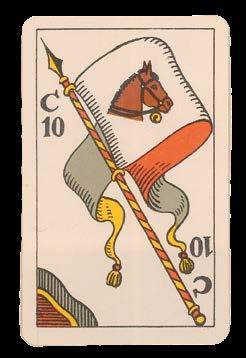

104 DANIEL CROUCH RARE BOOKS EVERY HAND’S A WINNER
48



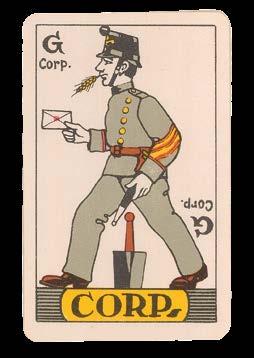
Bullfighters and chocolate
[DURÁ, Simeon]
Baraja Taurina.
Publication
Valencia, [Simeon Durá], 1916.
Description
48 chromolithograph playing cards, with named portraits to verso, one duplicate card.
Dimensions
95 by 62mm (3.75 by 2.5 inches).
£800
The Makers
Active in the final decades of the nineteenth century and the opening decades of the twentieth, Simeón Dur of Valencia was among the most prominent cardmakers in Spain. Initially, Durá published decks using the same design as the earlier Manaut Brothers firm, from whom he had taken over business, but later expanded his range to include original designs printed using modern lithographic equipment. Both the introduction of the card tax in 1904, and the Spanish Civil War decades after, put great strain on the Durá firm, and by the 1950s it had stopped producing playing cards, instead operating as a general printing company, which it continued to do until 1970 under Durá’s sons. The present deck was produced for Chocolates Angelical of Barcelona; at this time many Spanish chocolatiers sold their goods accompanied by a collectable card or deck of cards for promotional purposes.
The Cards
The Spanish suit system has been adapted here so that the coins are represented as medallions, each containing a portrait of a famous bullfighter, and clubs as the torero’s banderilla, a short fabric-covered stick with a barbed dart at the end. These reflect the overarching theme of the deck: the bullfight. These symbols, alongside cups and swords, appear on the Two to Nine pip cards in numbers reflecting the card’s value. On each of the cups, which appear to be small shot glasses, the iron of a bull breeder is shown. These branding irons had become something like logos for the various farms and breeders that provided bulls for the fights.
On the Ace of each suit are the leading bullfighters of the dayRafael Molina “La Gartigo”, Rafael Guerra Guerrita and Juan Molina - and on the Cups, the iron of the most prestigious bullbreeder in Spain, the Duque de Veragua. The court cards likewise show prominent fighters, all identified by name. To the verso of each card is also a portrait of a torero, again with his name written outside of the frame, as well as the advertisement for Chocolates Angelical.
106 DANIEL CROUCH RARE BOOKS EVERY HAND’S A WINNER
49
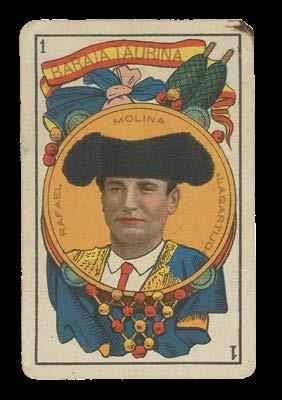

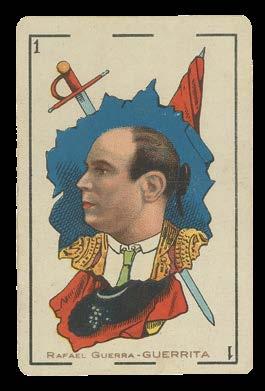

Luck of the Irish
W & G BAIRD Ltd
Irish Playing Cards - The Historic Set.
Publication
[Cork, Irish Playing Card Mfg Co., c1920].
Description
52 chromolithograph playing cards, with joker and printed paper instruction booklet, housed in original slipcase.
Dimensions
90 by 60mm (3.5 by 2.25 inches).
£800
The Maker
Founded in 1862, W & G Baird Ltd of Belfast remains in operation today as a printing firm. They produced a wide variety of material including prints, propaganda and programmes. Alongside the present deck, the company also published a deck devoted to ‘heroic’ Irish history, featuring characters from native folk-tales and legends.
The Cards
Perhaps produced during the Irish War of Independence (1919-1920), this deck celebrates Irish history and culture. The backs of the cards decorated with an artistic Celtic pattern in four different colours, while the Jacks are harpers, a symbols associated with the land since the thirteenth century. The Kings and Queens depict historic members of royalty:
Clubs - Niall, Cairenn
Diamonds - Cormac Macairt, Ethne
Hearts - Brian Boru, Gormlaith
Spades - Lóegaire, Fedeln
The backs show typical Celtic decorative artwork. The pip cards are standard, with the number of suit marks reflecting the value of the card, which is written in Arabic numerals in opposite corners, with a miniature suit mark beneath it.
108 DANIEL CROUCH RARE BOOKS EVERY HAND’S A WINNER
50

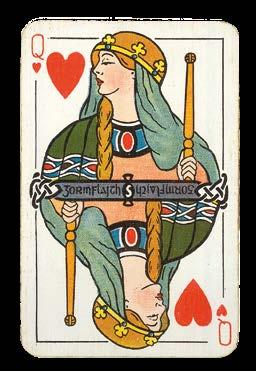
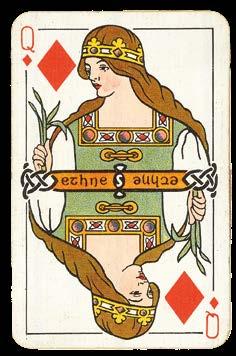
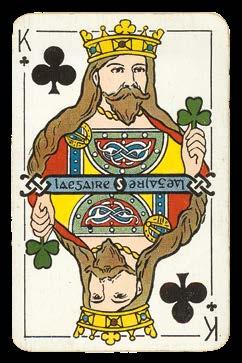
Hijos de [Sons of] FOURNIER, Heraclio
[Cadiz pattern Spanish cards]. Publication
The Makers
In 1870, Heraclio Fournier González founded a print shop in Vitoria in northern Spain, where seven years later he published his first deck of cards, designed by Emilio Sobrier and Díaz de Olano. Investing in the latest machinery, Fournier published award-winning twelve-colour lithographic decks. After Fournier’s death in 1916, the firm continued to work at the leading edge of Spain’s playing card production, becoming the official supplier of decks to various royal families around the world. In 2020, Fournier was acquired by Cartamundi but continues to publish their own decks.
The Cards
The Cadiz pattern of playing cards is almost identical to the Castilian pattern, using the Spanish suits of Clubs, Coins, Cups and Swords, and is distinguished only by a few small details: the Knight of Coins has a whip, and the King of Cups holds his sceptre in his left hand. Its 40 cards are comprised of Ace to Seven pip cards, with three court cards, the sota (knave), caballo (knight) and rey (king). Some of the cards have inscriptions, including the publisher’s imprint on the Five of Spades, “Made in Spain” on the Four of Clubs, and “ahi vá” on the Caballo of Cups. Strangely, the accent has been put over the wrong letter; it should read “ahí va”, a Spanish phrase used in a variety of situations that can loosely be translated as ‘there you go!’.
110 DANIEL CROUCH RARE BOOKS EVERY HAND’S A WINNER
Vitoria, Hijos de
Description 40 chromolithograph playing cards, with black dotted pattern to verso. Dimensions 96 by 63mm (3.75 by 2.5 inches). £250
Heraclio Fournier, [c1920].
va! 51
Ahí

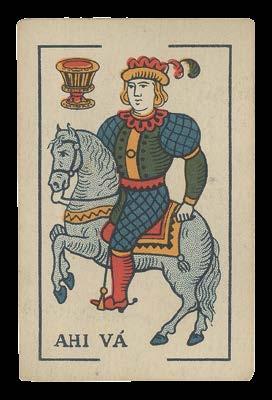
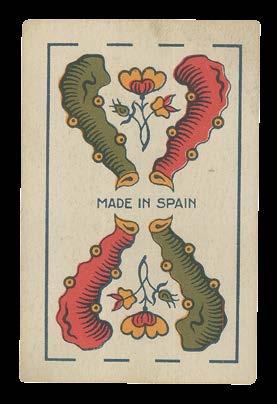
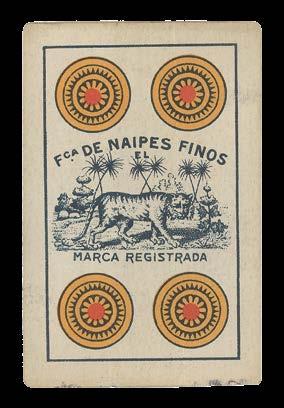
[VERCHER COLL, Antoni]
Cine Manual.
Publication
[Valencia, Reclamos Cimadevilla, c1927].
Description
48 chromolithograph playing cards, with numbered cat illustration to verso.
Dimensions
93 by 57mm (3.75 by 2.25 inches).
£500
Chocolate Heroes
The Maker
Published by the Reclamos Cimedevilla firm in Valencia around 1927, this deck was designed by Catalan painter and illustrator Antoni Vercher Coll. Vercher published caricatures in a number of Spanish newspapers and periodicals, as well as illustrating several important books. It seems, however, Vercher’s designs were only ever transformed into a single deck of playing cards.
The Cards
Using the traditional Spanish system, in which suits are categorised as Coins, Cups, Clubs and Swords, the symbols for these suits are incorporated into the design of each image, meaning that the cards can be considered a “transformation deck”.
The court cards depict male icons from the 1920s, all portrayed in the contemporary art-deco style. They include movie stars such as Charlie Chaplin and Douglas Fairbanks, explorer Roald Amundsen, aviation pioneer Charles Lindbergh, motorcycle racer Vincente Riera, as well as famous sportsmen. The pip cards show a variety of sports, such as polo, football, cycling, rowing, boxing, skiing and tennis. On the back of each card is a numbered image. When viewed quickly, one after another, they form a so-called “flick-book”, an artificial “movie” starring Periquito the cat!
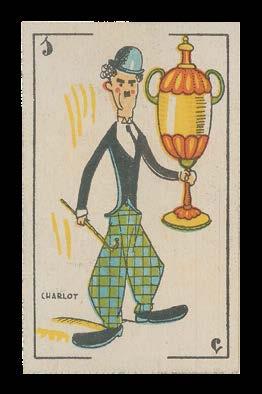

112 DANIEL CROUCH RARE BOOKS EVERY HAND’S A WINNER
52

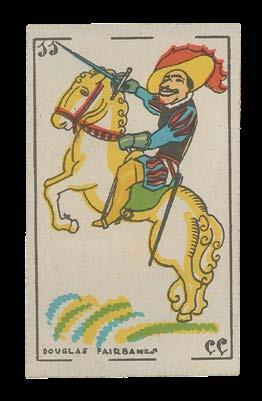
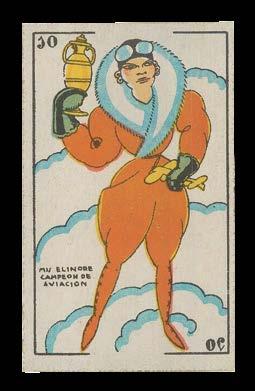

CHOCOLATE DE AMATLLER [Futbolistas].
Publication
Barcelona, S. Martin de Provensais, [c1930].
Description
48 chromolithograph playing cards, with leaf pattern and logo to verso.
Dimensions
95 by 60mm (3.75 by 2.25 inches).
£500
A football game
The Makers
As advertised on the back of each card, this deck was published by Spanish chocolate company “Chocolates Amatller S. A. Barcelona”. Founded in 1797, Amatller remains one of the oldest active chocolatiers in Europe. Throughout its history, and particularly during the early twentieth century, the company engaged in advanced advertising campaigns, frequently produced playing cards as promotional material.
The Cards
The traditional Spanish suit system of cups, clubs and swords, is used, with the exception that instead of coins, there are balls. Pip cards have their values represented by the number of suitmarks shown, while the court cards and Aces show successful Spanish football players of the early twentieth century, with a miniature representation of the traditional playing card in the lower left-hand corner. The Ace of Coins shows the legendary goal keeper, Ricardo Zamora, nicknamed ‘el Divino’ (‘the divine’). A native Catalonian, he played for Barcelona and Real Madrid, as well as RCD Espanyol, as listed on the present example. The trophy for the goalkeeper who has the lowest “goals-to-games” ratio in the Primera División is named after Zamora.


114 DANIEL CROUCH RARE BOOKS EVERY HAND’S A WINNER
53
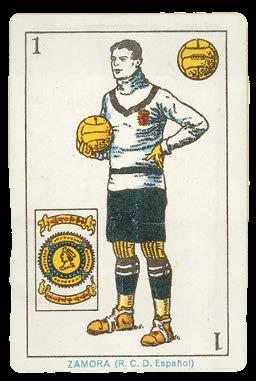
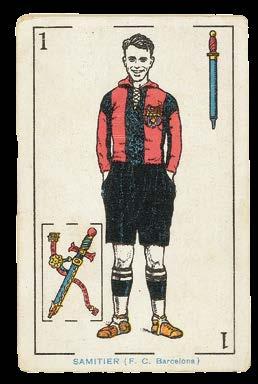


[NARSINGAM VERMA, Busani]
[Atharangi Ganjifa].
Publication
[Nizamabad, Nirmal Art, c1955].
Description
96 circular playing cards housed in original wooden box.
Dimensions
(diameter) 50mm.
£1,200
An Indian deck of 96 circular playing cards
The Maker
This set of Ganjifa playing cards were made in Nirmal, Nizamabad in Andhra Pradesh, India. The town has long been a centre of artisanal production; during the seventeenth century an eponymous chieftan brought craftsman and their families to live and work there. During the following centuries, Nirmal became famous for the toys, furniture and other articles built from the woods of local trees, mainly poniki or white sander. During times of conflict, however, its artisans were forced to produce weapons of war, including cannons! In 1955, the Indian government establlished The Nirmal Toys and Arts Industries Cooperative Society Ltd. which preserves ancient cultural crafts. When the society was founded, only one craftsman was permitted to produce the Ganjifa playing cards it published, Busani Narsimlu Verma.
The Cards
The historic card game of Ganjifa is one of the most variable games, with its spelling, the design of its cards, its suit system, the number of cards and players, and the rules changing depending on when and where it is played. Originating in Persia as early as the twelfth century, Ganjifa became popular across Asia throughout the following centuries, with India ultimately becoming the last country to produce the cards, mainly in the state of Odisha.
Although rectangular versions are found, Ganjifa cards are recognizable by their circular shape and often ornate designs, which were traditionally hand-painted by artisans. As a popular form of entertainment at the Mughal court, lavish sets were made from materials such as ivory or tortoise shell, before cheaper wooden, cloth or pasteboard sets started to be mass produced for the popular audience.
The cards typically have brightly-coloured backgrounds according to their suits. Although suit systems vary greatly, in most games each suit contains ten pip cards and two court cards: the King and the Vizier. In terms of value, the King is the most highly-ranked card, followed by his Vizier, and then the pip cards from 1 (strongest) to 10 (weakest). An old and influential Arabic variant of the game used the four suits Coins, Cups, Polo-sticks and Swords, while other known versions were played with as many as 30 different suits!
The present deck has eight suits, represented by various symbols and illustrations, each set on a different background in shades of green, orange, red, black and yellow. As expected, each suit has ten pip cards, a King and a Vizier. This system suggests that these cards were designed to play the Atharangi variant of Ganjifa, created in the Indian state of Odisha. The King card shows the ruler seated cross-legged, while on the Vizier, the king is seated on a horse with his advisor standing before him.
116 DANIEL CROUCH RARE BOOKS EVERY HAND’S A WINNER
54

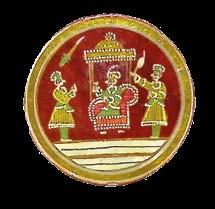

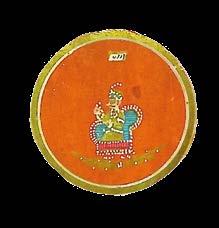

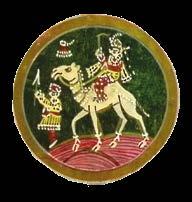
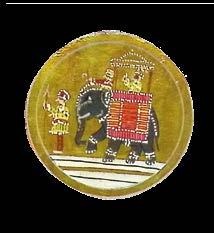
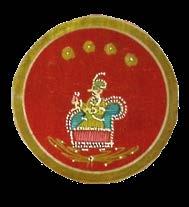
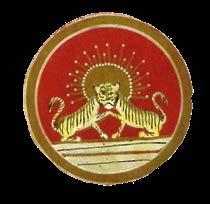
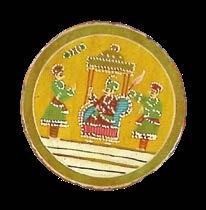
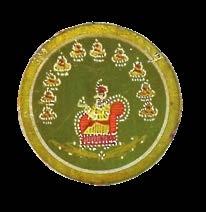

[ANONYMOUS]
[Mughal Ganjifa].
Publication
[mid-twentieth century].
Description
96 circular playing cards housed in original wooden box.
Dimensions (diameter) 80mm.
£1,200
Mughal Ganjifa
The Maker
The maker of this set of Ganjifa playing cards remains anonymous.
The Cards
The historic card game of Ganjifa is one of the most variable games, with its spelling, the design of its cards, its suit system, the number of cards and players, and the rules changing depending on when and where it is played. Originating in Persia as early as the twelfth century, Ganjifa became popular across Asia throughout the following centuries, with India ultimately becoming the last country to produce the cards, mainly in the state of Odisha.
Although rectangular versions are found, Ganjifa cards are recognizable by their circular shape and often ornate designs, which were traditionally hand-painted by artisans. As a popular form of entertainment at the Mughal court, lavish sets were made from materials such as ivory or tortoise shell, before cheaper wooden, cloth or pasteboard sets started to be mass produced for the popular audience.
The cards typically have brightly-coloured backgrounds according to their suits. Although suit systems vary greatly, in most games each suit contains ten pip cards and two court cards: the King and the Vizier. In terms of value, the King is the most highly-ranked card, followed by his Vizier, and then the pip cards from 1 (strongest) to 10 (weakest). An old and influential Arabic variant of the game used the four suits Coins, Cups, Polo-sticks and Swords, while other known versions were played with as many as 30 different suits!
The present cards are an example of the prominent variant, Moghul Ganjifa, played in parts of Odisha with 96 cards in eight suits of 12 cards each. Each deck comprises pip cards from One to Ten, and two court cards: a vizier and a king. The suits used are slaves, crowns, swords, red coins, harps, bills of exchange, white coins and cloth; strangely, this deck does not devote a distinct colour to each suit, there being two yellow suits, two green and two red, as well as a brown and black.
118 DANIEL CROUCH RARE BOOKS EVERY HAND’S A WINNER
55


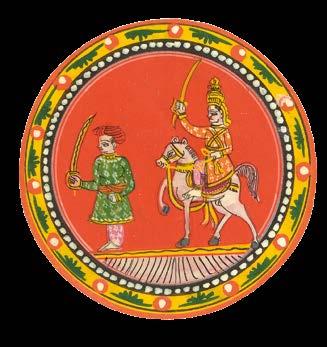
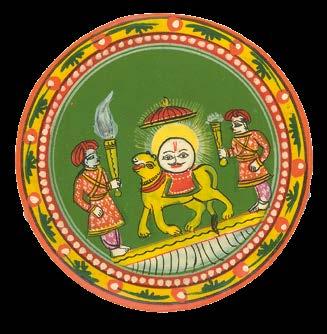
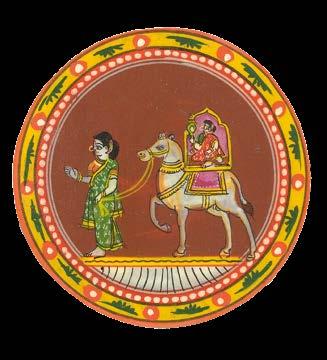
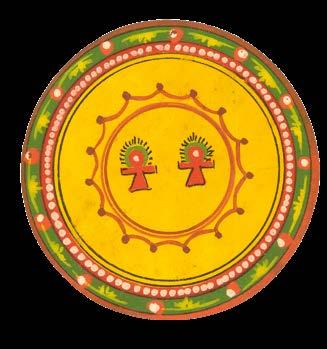

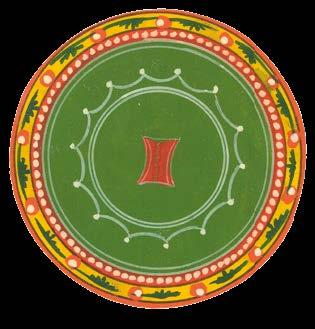



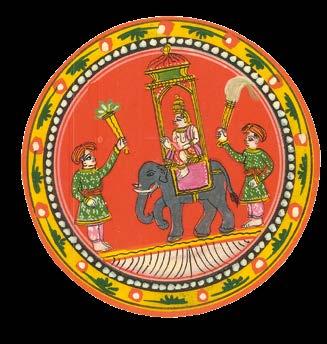
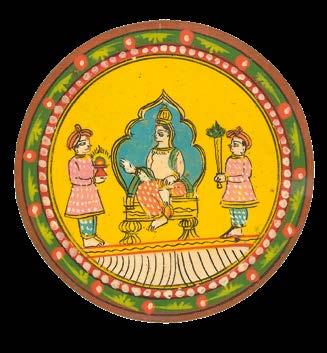
MALKA FRERES [after CAMOIN]
[Caravelle].
Publication
Casablanca, Malka Freres, [c1971].
Description
40 playing cards with airplane motif to verso.
Dimensions
86 by 56mm (3.5 by 2.25 inches).
£300
Casablanca cards
The Maker
There are records of a Jewish family named Malka living in Morocco during the twentieth century, who may have been the proprietors of Malka Freres. While their output of cards seems to have been limited to the one Casablanca deck taken from the defunct Camoin firm, they published it multiple times with different wrappers and boxes.
The Cards
Based on the Spanish National pattern for playing cards designed by Félix Solesio in Madrid at the turn of the nineteenth century, the Casablanca pattern is so-named because it was the standard deck made for import into Morocco and Algeria. French and Spanish manufacturers including La Ducale, B.P. Grimaud and Camoin were at the forefront of these European exports. Using the Spanish suits of clubs, coins, cups and swords, with full-length court cards depicting the sota (jack), caballo (knight) and rey (king), the Casablanca pattern has the French-Catalan style king card, in which the figure wears long robes covering his feet. The pip cards have their values represented by the corresponding number of suit marks, often accompanied by other decorative elements such as flowers.
After the closure of the Camoin firm in 1971, many of its decks were appropriated by various other printers, including Malka Freres in Casablanca. As a Moroccan company, they were able to cater better to their audience by replacing the original French imprints with Arabic. They also removed the publisher’s imprints originally found on Camoin’s court cards. Otherwise, the design is just the same. Interestingly, the Malka deck was originally issued in a wrapper advertising the Caravella aircraft, which also appears as a design on the verso of each card. The French jet airliner, which flew between Paris-Orly and Casablanca Airport during the latter-half of the twentieth century, sadly became infamous for a number of fatal crashes in the 1970s.
122 DANIEL CROUCH RARE BOOKS EVERY HAND’S A WINNER
56



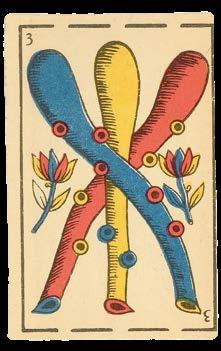
Stained glass cards
KÜMPEL-AMSLER, Gertrud
Vitrail-Bridge.
Publication
Neuhausen, AG Müller, 1991.
Description
52 chromolithograph playing cards, with three jokers and four pages of description on paper, housed in original case.
Dimensions
116 by 56mm (4.5 by 2.25 inches).
£1,500
The Maker
Swiss artist Gertrud Kümpel-Amsler was commissioned to design a cardthemed stained glass window for the offices of the great card manufacturers, AG Müller. Her work on the project proved such a success that in 1989 she was asked to design a deck of cards along a similar theme.
The Cards
This deck has a striking and unique design, combining the style of stained glass with the art deco genre. Each suit is represented in two colours: Clubs in orange and blue, Diamonds in green and orange, Hearts in blue and red, and Spades in red and green. The pip cards have no numerals, with their values instead represented by the number of suit marks. The court cards have a single full-length figure on each, which appear to represent the classic royal figures, some holding sceptres. The three jokers are also full-length figures, in rather more strange poses, and labelled “joker”. The Queen of Diamonds is featured on the slipcase in which the deck is housed, which also includes four pages detailing the design of both the windows and the cards, discussing the colour, symbolism and manufacture of the deck Kümpel-Amsler’s cards were originally published as a numbered edition of 150 decks. This was soon followed by another unnumbered edition, as here.
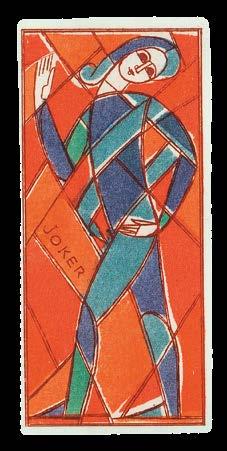
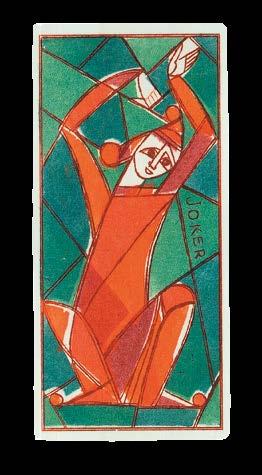
124 DANIEL CROUCH RARE BOOKS EVERY HAND’S A WINNER
57
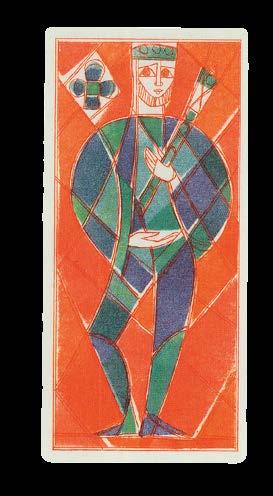
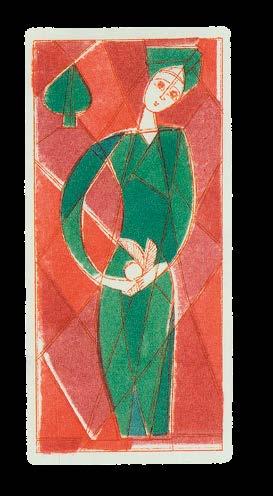
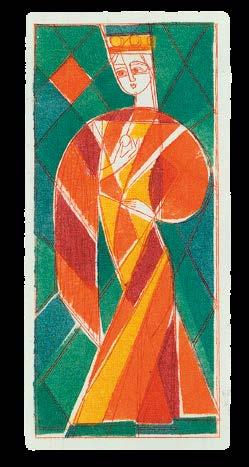
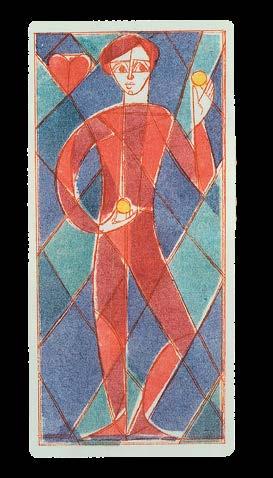













































 MOXON, Joseph [and] James
MOXON, Joseph [and] James















































 GÖBL, Andreas Benedict Baierische Hochzeit
GÖBL, Andreas Benedict Baierische Hochzeit




















































































 GLANZ, Jos[eph]
GLANZ, Jos[eph]


























































































































